namo gaura-kisoraya saksad vairagya-murtaye
vipralambha-rasambudhe padambujaya te namah
I offer my respectful obeisances unto Gaurakisora Das Babaji Maharaja, who is renunciation personified. He is always merged in a feeling of separation from and intense love of Krishna.
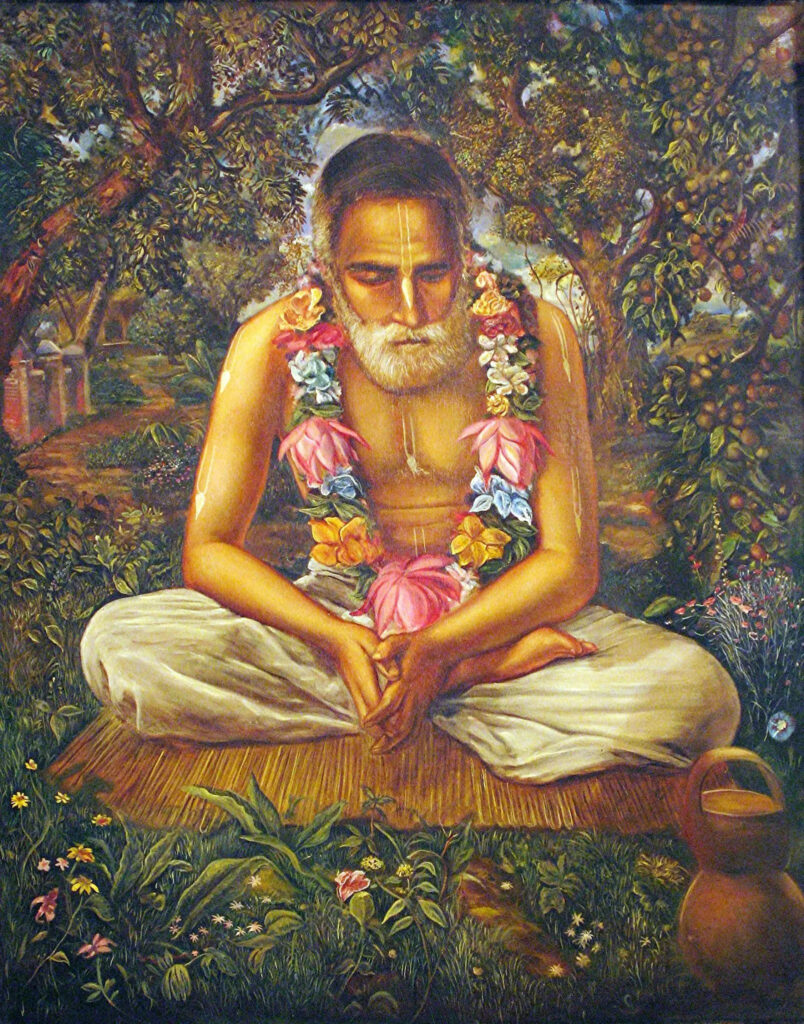
Srila Gaurakisora Das Babaji appeared in Bagayana village in the district of Faridpur in what is now Bangladesh, on the shore of the Padma River. He was born into a mercantile family. Some biographers say he was born in 1838 – the same year as Srila Bhaktivinoda Thakur. Others say that he appeared sometime in the mid-1800s. During boyhood, his mother and father arranged for an early marriage. He remained in household life until he was twenty-nine years old, working as a broker in the grain business. After the death of his wife, Srila Gaurakisora left his business and approached Srila Bhagavat Das Babaji, a disciple of Srila Jagannatha Das Babaji, in order to accept the traditional Vaisnava babaji dress. At this time he was given the name Gaurakishora Das Babaji.

Padma River at Faridpur
After taking babaji initiation from Srila Bhagavat Das Babaji, Srila Gaurakisora travelled from village to village in Vrindavan, continually performing solitary worship of Lord Krishna for thirty years. During this time, he would sometimes also travel to the holy places in northern India, as well as to the nine islands of Navadvipa. Srila Gaurakisora Das Babaji became very famous among the paramahamsa devotees in Vrindavan during that period, and was recognized as a bhajananandi, a renounced solitary worshipper.
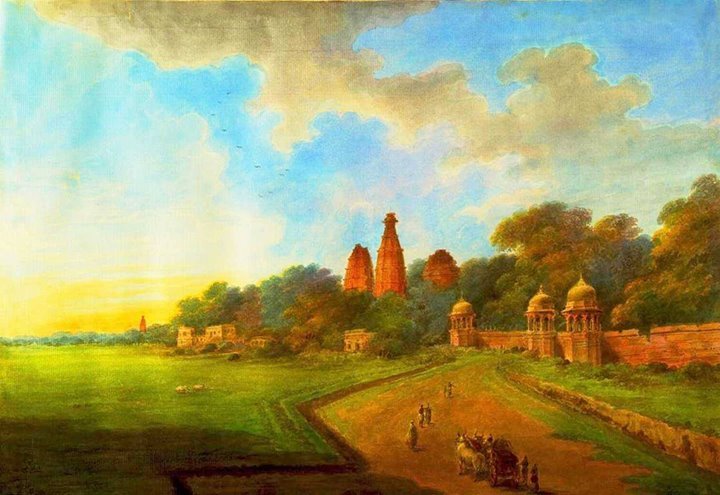
Vrindavan 1800s
Although Srila Gaurakisora Das Babaji received great honour and respect, he had not a skerrick of interest in fame or any kind of material sense enjoyment. Babaji Maharaja entirely rejected such inclinations and simply performed his pure devotional pastimes in a deep mood of renunciation. Sitting in seclusion, he chanted 200,000 names of Krishna every day (128 rounds of japa). He felt painful separation from Radha-Govinda and cried profusely. As he wandered through the twelve forests of Vraja, he would loudly chant the Holy Names in a deep voice full of lamentation.
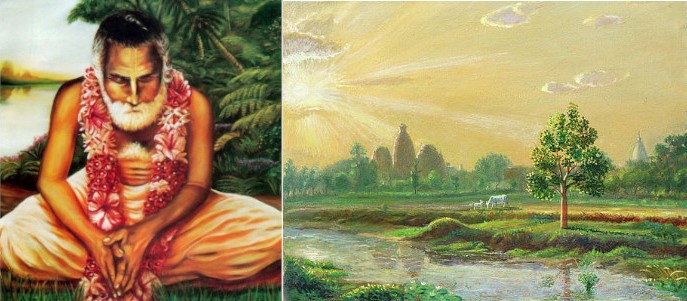
In March, 1894, when the Yoga Pitha [birthplace of Lord Chaitanya] in Mayapura was revealed, Srila Gaurakisora Das Babaji took the permission of Srila Jagannath Das Babaji to go to Navadvipa Dhama from Vrindavan Dhama. From this time until his disappearance in 1917, Srila Gaurakisora stayed in the area of Sri Navadvipa Dhama, living in different holy villages, realizing them to be non-different from Vrindavan.
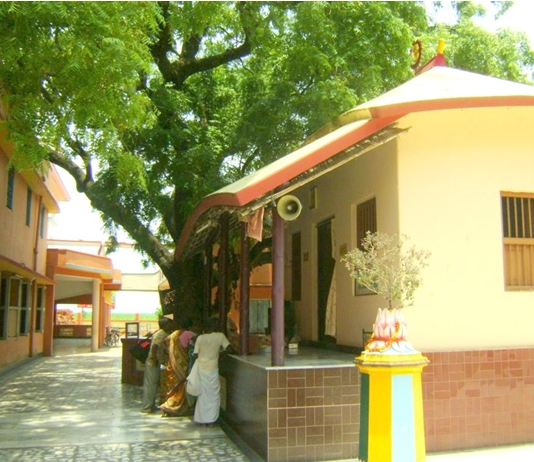
The Yogapitha – the Birthplace of Lord Chaitanya
He would gather dry foodstuffs from the householders of the holy dhama by begging, and offer them in his hand to the Lord. To cook, he would often collect dry wood from the pathways and wash discarded pots he found along the roadside near the Ganges. To meet his practical necessities such as clothing himself, he would go to the shore of the Ganges River and collect and wash the discarded cloth that had been used to cover the corpses in the burning grounds. In this way he always remained independent of others by using rejected items that served no purpose for anyone.
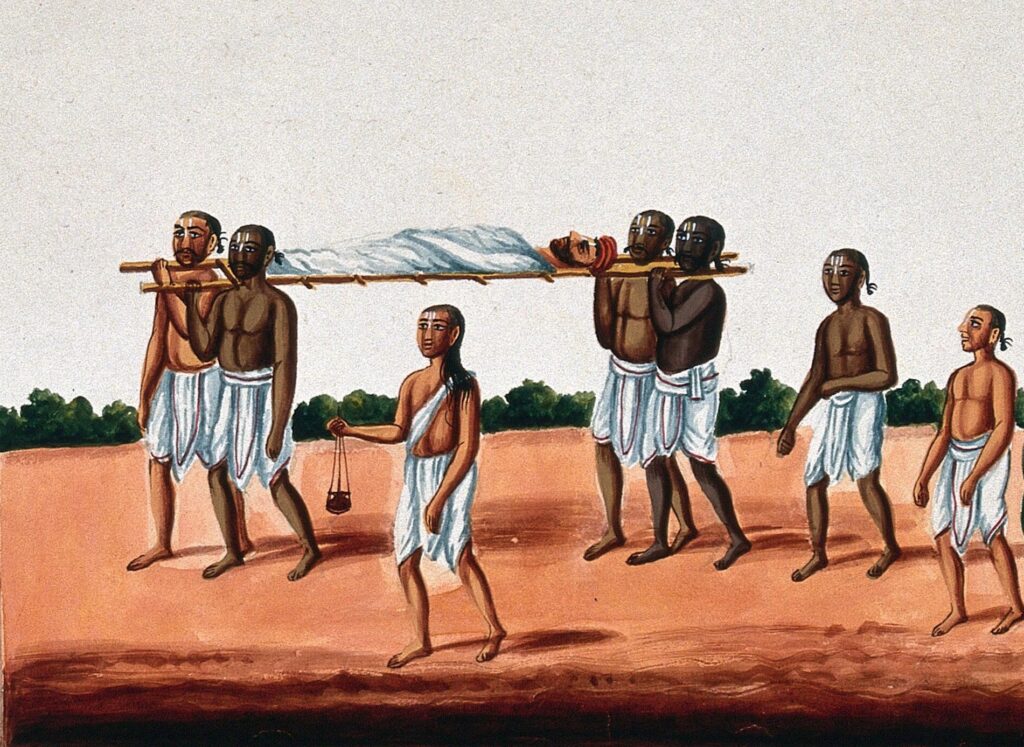
Srila Bhaktivinoda Thakur often related the behaviour of Srila Gaurakisora Dasa Babaji as an example of “nirapeksa,” or total indifference to worldly existence. He often discussed the matchless renunciation, pure dedication, and spontaneous attachment to Krishna that Babaji Maharaja displayed. Sometimes Babaji Maharaja would visit Godrumadvipa, one of the nine islands of Navadvipa where Srila Bhaktivinoda spent his last days in retirement.
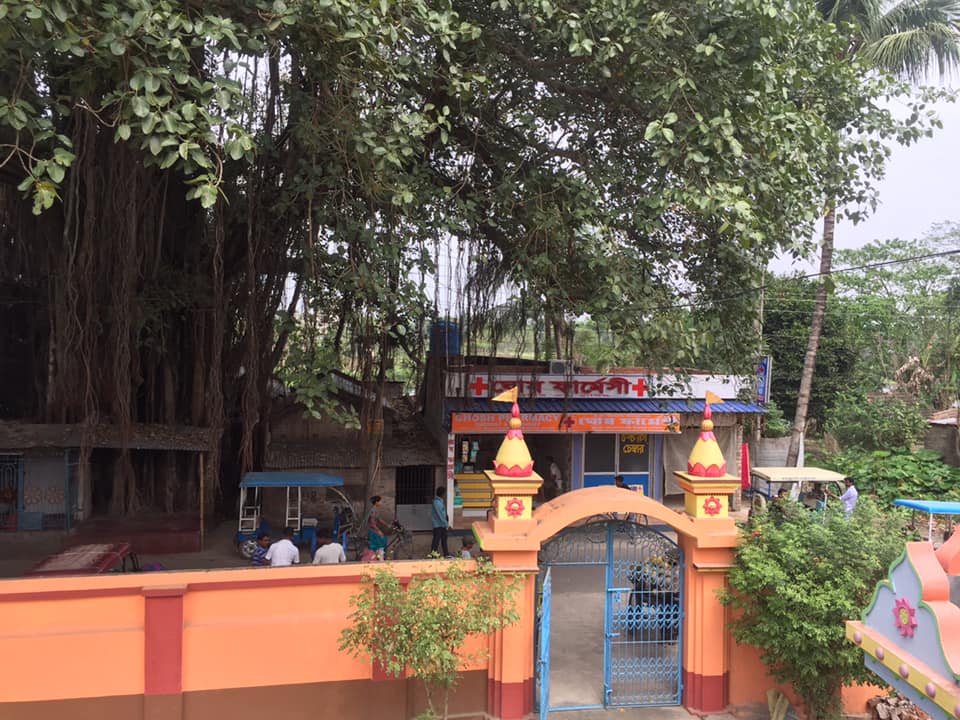
Godrumadvipa Today
Godrumadvipa is non-different to Nandagrama in Vrindavan, where Nanda Maharaja has his palace. Srila Gaurakisora Das Babaji would often go there to the charming garden known as Svananda-sukhada-kunja and hear discourses on the Srimad-Bhagavatam and other topics concerning the devotional service of the Lord. This enhanced his mood of dedication. His entire wealth included a necklace of Tulasi beads and a set of Tulasi mala he kept in his hand for counting the Lord’s names. He also cherished hearing from a few Bengali literatures, such as Narottama Das Thakur’s Prarthana and Prema-bhakti-candrika.
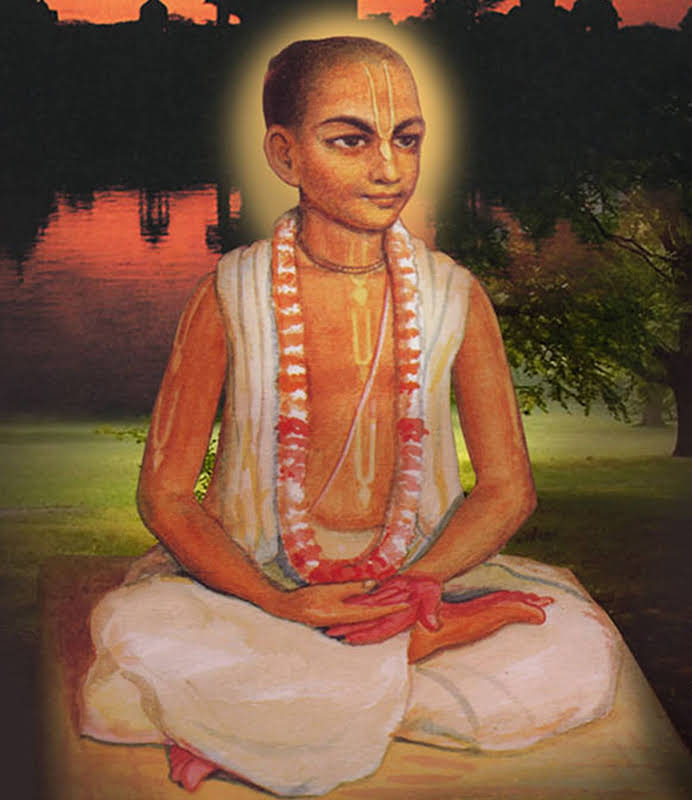
Narottama Das Thakur
It is told that Srila Gaurakisora Das Babaji, in a deep trance of spiritual love, would sometimes forget to dress, and would be seen holding a torn knotted cloth in his hand for chanting, or utter harsh sounds in seeming disgust for no apparent reason. Although by worldly standards Srila Gaurakisora was said to be illiterate, he perfectly understood and could explain the purport and conclusions of all the scriptures, and was faultless in his character. It was impossible for anyone to secure an opportunity to serve him. He was never eager to accept any manner of service from anyone. Learned devotees who saw his genuine state of renunciation would be reminded of the exemplary life of Srila Raghunath Das Gosvami.
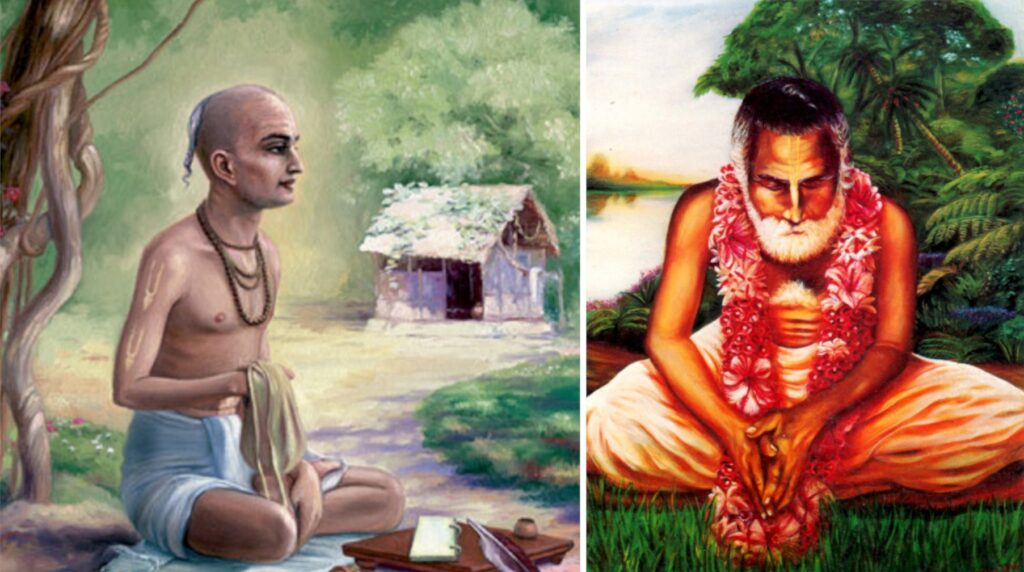
Raghunath Das Goswami and Srila Gaurakisora Das Babaji
Srila Gaurakisora Das Babaji was disgusted by the behaviour of pretend bhajananandis, and was always able to expose the cheating tendencies lying within the hearts of the imitationist sahajiyas. Although a person may have lived far away, Srila Gaurakisora could scrutinizingly reveal the falsehood which they perpetrated in the name of the Lord’s service, thus saving others from the hands of insincere cheaters. But the ability to communicate with the Lord in the heart was not Srila Gaurakisora’s only virtue. Babaji Maharaja exhibited the highest mood of pure dedication to the Supreme Lord, because his perfect character was the personification of love in the mood of deep separation from the treasures of his life, Radha and Krishna. This deep internal mood of separation distinguished him from so many other Vaisnavas.
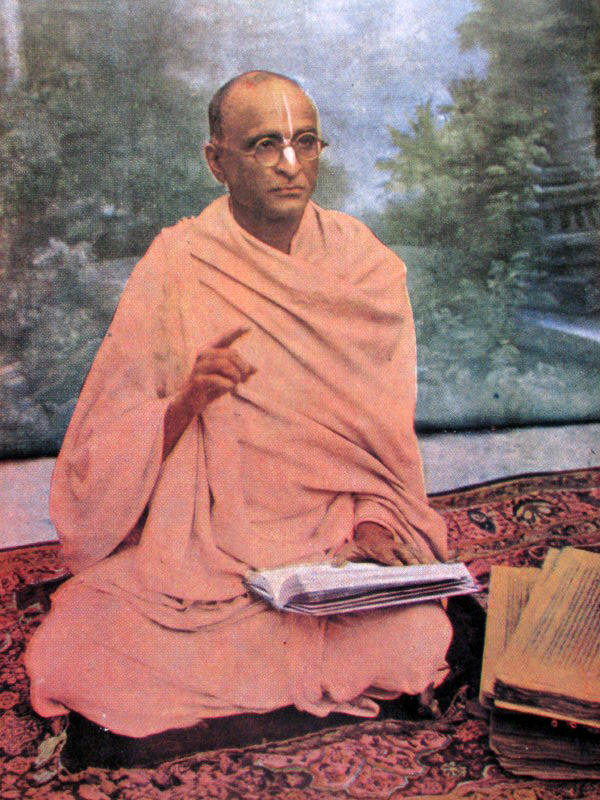
Srila Bhaktisiddhanta Sarasvati Thakur has written of Srila Gaurakisora:
Many types of persons – clever, judicious, young, old, foolish, scholarly, and proud – came into contact with Srila Gaurakisora, yet could not realize his real identity. This is the mystic opulence of the Lord’s pure devotee. Hundreds came and consulted with Srila Gaurakisora about their insignificant material desires. He would always give them suggestions which were in fact meant to deceive them. Innumerable men accepted the babaji dress and pretended to be exalted devotees of the Lord. However, my master, Srila Gaurakisora, never accepted a devious mode of life, as the sincerity in his activities was self-evident. His affectionate nature was matchless, and whenever he would obtain opulent offerings, he remained fixed in his renunciation.
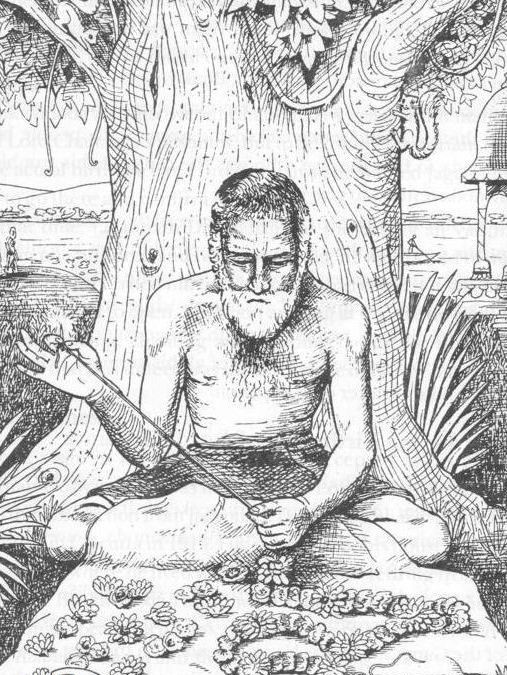
Srila Gaurakisora never displayed any distaste for his detractors, nor did he exhibit any special affection for those who were attached to him. He would often say:
I am not inimical or overly affectionate towards anyone. Everyone is worshipable by me.
During the lifetime of Srila Gaurakisora Das Babaji, many foolish and devious materialists, whose motives and actions were in opposition to the conclusions of pure devotion, would come and surround him, considering themselves the dearmost objects of his affection. Although they engaged themselves in the pursuit of worldly things, Srila Gaurakisora tolerated them without ever showing symptoms of compromise in his own behaviour.
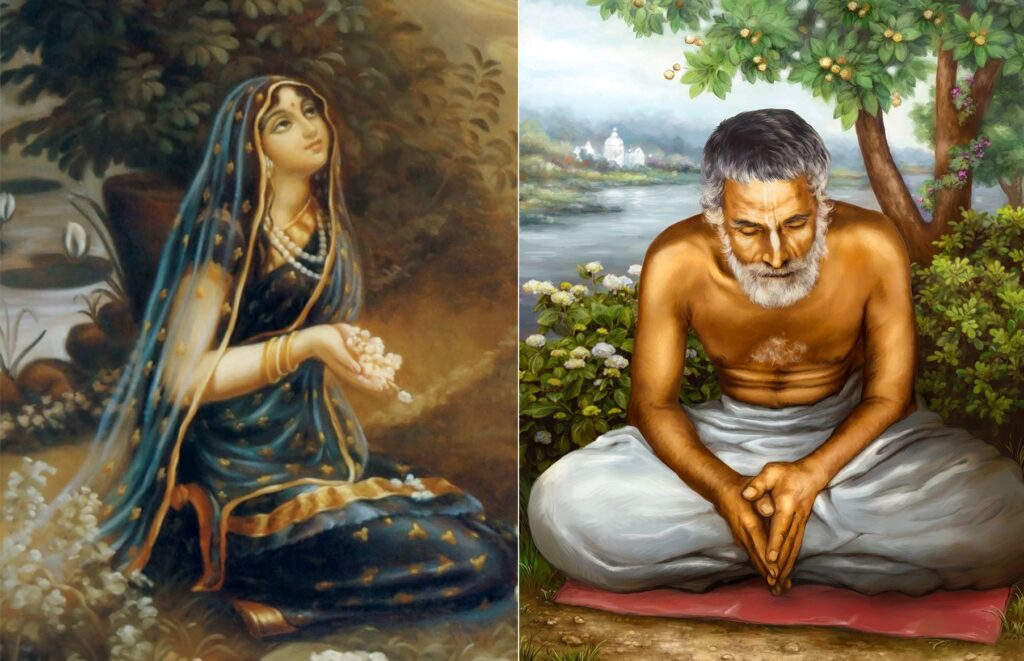
In 1898, Srila Bhaktisiddhanta Sarasvati Thakura was staying in Godrumadvipa, just after Bhaktivinoda Thakur’s garden of Svananda-sukhada-kunja had been built. At this time Sarasvati Thakur first met his spiritual master, Srila Gaurakisora Das Babaji. One day, humbly following the direct instruction of Srimati Radharani, and chanting in a sad voice, Srila Gaurakisora arrived in the beautiful garden of Svananda-sukhada-kunja.
Srila Gaurakisora was wearing a tiger-skin cap and carrying a basket containing various paraphernalia used in his personal bhajan. Srila Gaurakisora had previously received the basket and cap from his spiritual master, Srila Bhagavata Das Babaji, in Kalana. Srila Bhagavata Das Baji had in turn received them from his spiritual master, Srila Jagannath Das Babaji. After his arrival, he offered Srila Bhaktisiddhanta four or five sets of Tulasi beads, a wooden tilak stamp with the words “Hare Krishna,” the tiger-skin cap, and other personal items which he used when worshiping.
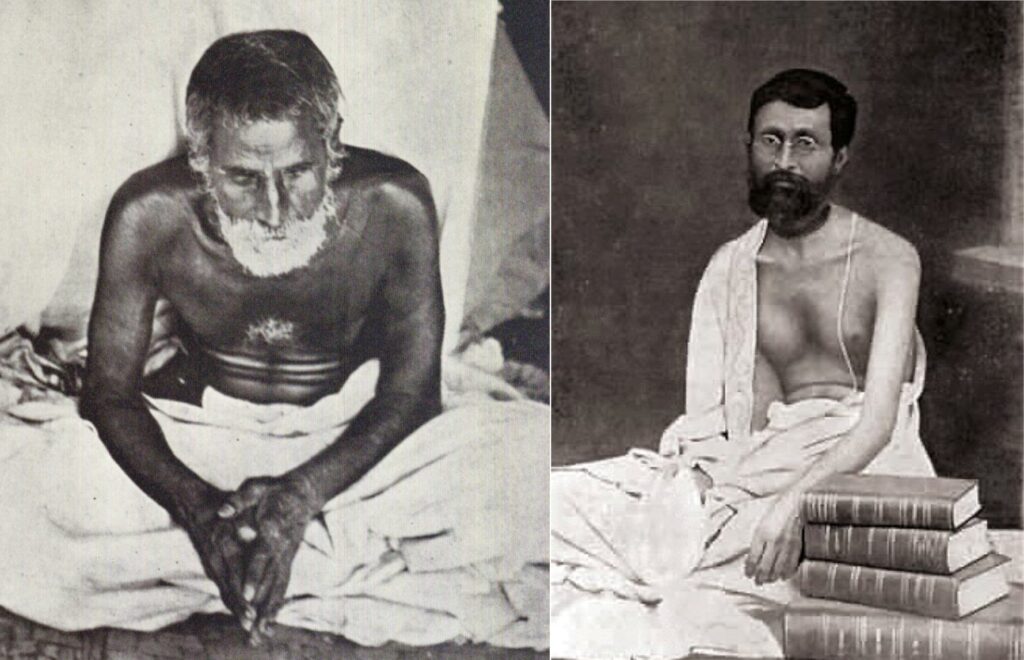
Sarasvati Thakur was enchanted by Babaji Maharaj’s heartfelt emotional kirtan. He wrote the kirtan down and later taught it to his own disciples. The song describes Raghunath Das Goswami’s ecstatic separation from Radha.The translation of this song reads:
Where is the incarnation of love, Radhe Radhe! Glories to Radha! Show yourself to me, Radha, give me back my life. I have become a beggar for you, Radha, and I am calling you. O Radha, you cavort in Vrindavan, you enchant Krishna’s mind, you are chief amongst the eight sakhis, and are the daughter of Vrisabhanu. Raghunath Das Goswami regularly and constantly calls out to you, Radha.
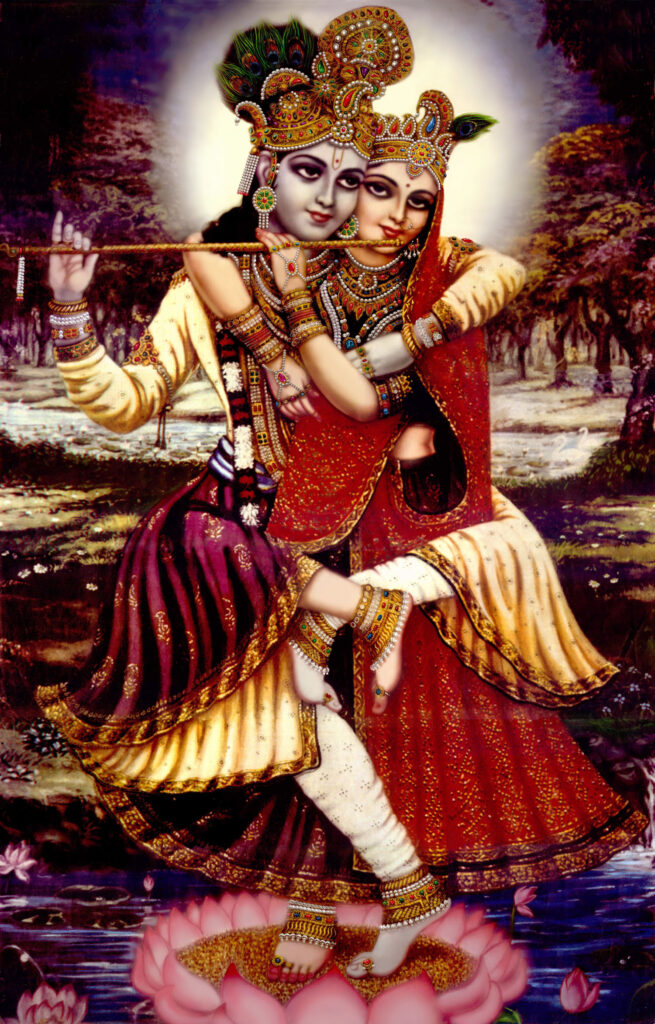
He calls for you in Kesi Ghat, in Vamsi Vata, Nidhuvan, Kunjavan, in Radha Kund and Shyama Kund, in Kusumavan and Govardhan, in Talavan and Tamalavan. He calls out wearing only a worn and dirty cloth and rolling in the Vrindavan dust. The names of Radha on his lips, his eyes are filled with tears. He wanders through every part of Vraja, calling Radha’s name. Night or day, for twenty-three hours he thinks of nothing but Radha and Govinda, and when he sleeps, he dreams of Radha and Govinda.
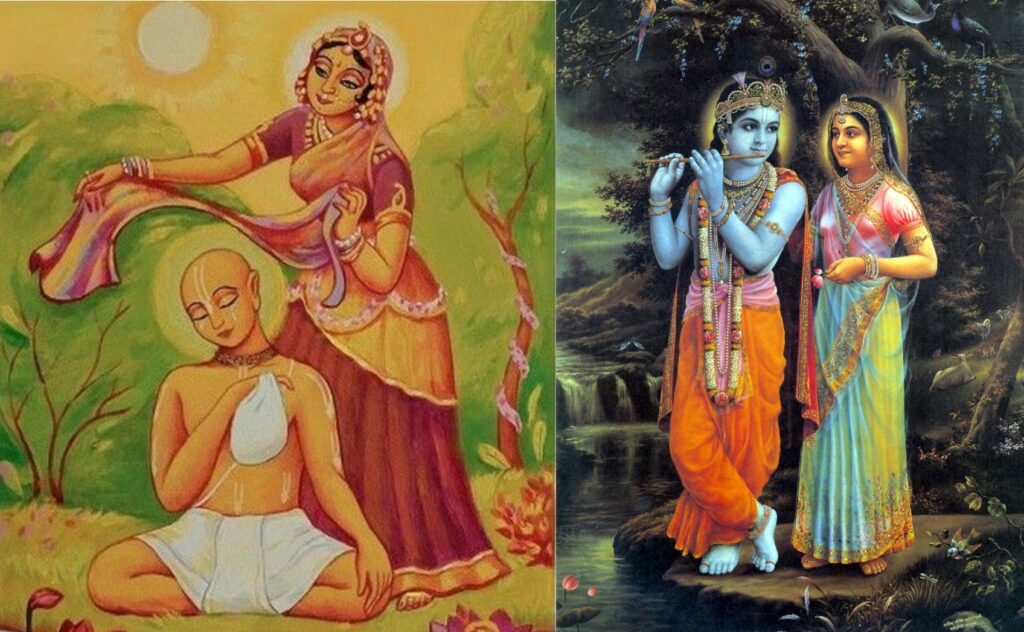
Raghunath Das Goswami shaded by Srimati Radharani and Radha-Krishna
The great devotee, Srila Gaurakisora, often came to the garden Svananda-sukhada-kunja to hear Srila Bhaktivinoda Thakur’s explanations of the Srimad Bhagavatam. He usually arrived at around three o’clock in the afternoon and left at five. On several occasions he spent the night in a corner of the garden in a small hut. Sometimes Srila Gaurakisora honoured prasadam from Svananda-sukhada-kunja and sometimes he fasted, while other times he cooked for himself. Concerned for his health, Srila Bhaktivinoda arranged a proper diet for him, but to his dismay, Babaji Maharaja continued to remain couched in a grave mood of renunciation, refusing to pay any attention to the diet.
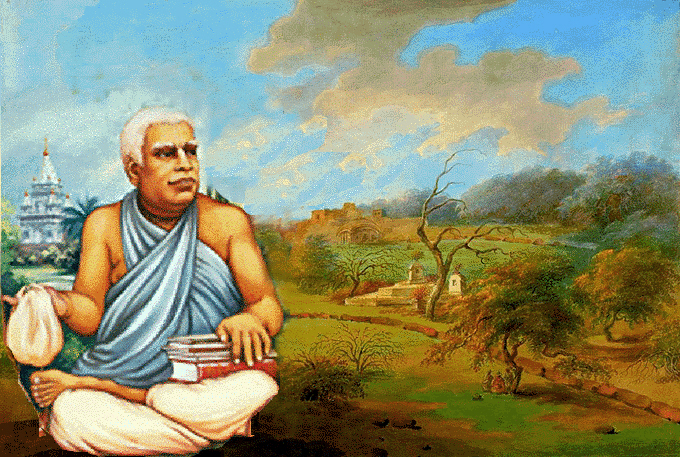
By 1908, Srila Gaurakisora had seemingly lost his external vision. The following year he stopped travelling and decided to reside in a bamboo hut in Navadvipa for performing his solitary bhajan. Srila Gaurakisora would live in Pradyumna kunja, and from there, visit or stay at Svananda-sukhada-kunja, where he would remember the Lord’s holy names in solitary worship. Being free from gross physical consciousness, Srila Gaurakisora often failed to recognize whether he was dressed or not. Thus, he often went unclothed to bathe at the Sarasvati River. After bathing, he would enter his small bhajan kutira [place of worship] and begin calling the cowherd maidens of Vrindavan in a deep voice.
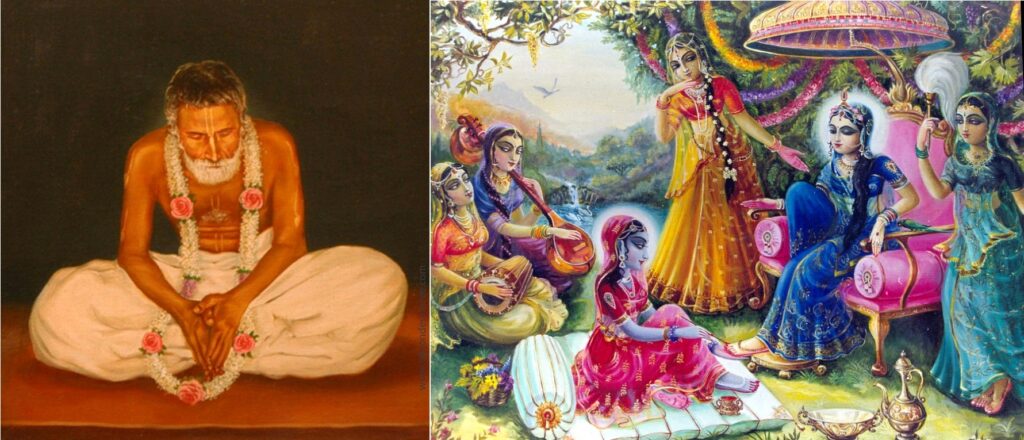
Because of his failing eyesight, Srila Bhaktisiddhanta Sarasvati asked him to go to Calcutta for proper medical treatment. Srila Bhaktivinoda also requested him many times to go there, but Srila Gaurakisora said:
I will never go to the world of maya, Calcutta.
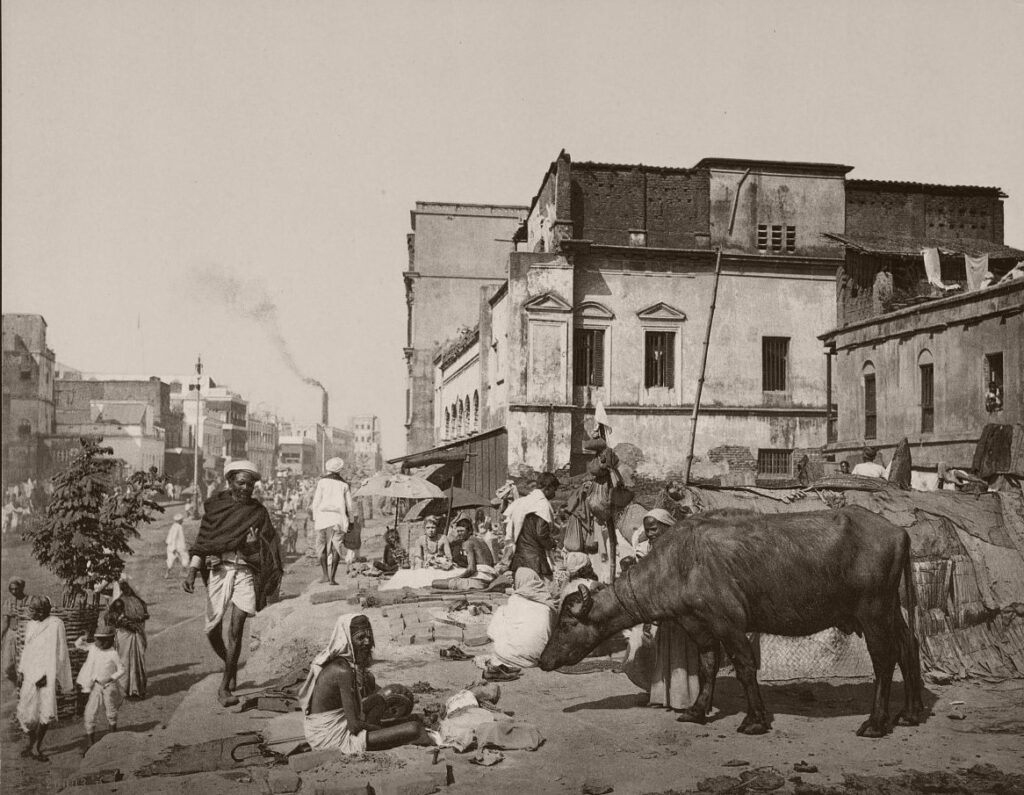
Kolkata (Calcutta) 1890s
Srila Bhaktivinoda then assured him that his servant, Srila Bhaktisiddhanta, would remain there with him in Calcutta so he would undergo no inconveniences. Upon hearing this, Srila Gaurakisora answered:
I will never accept his service. I will first drown myself in the Ganges River. If I drown myself, maybe I can take birth as a ghost.
Srila Gaurakisora stood up and began to quickly run towards the Jalangii River which flowed in front of Svananda-sukhada-kunja. Srila Bhaktisiddhanta, running behind him, humbly requested again and again that he come back, but he disappeared and was neither seen nor heard from for forty-five days.
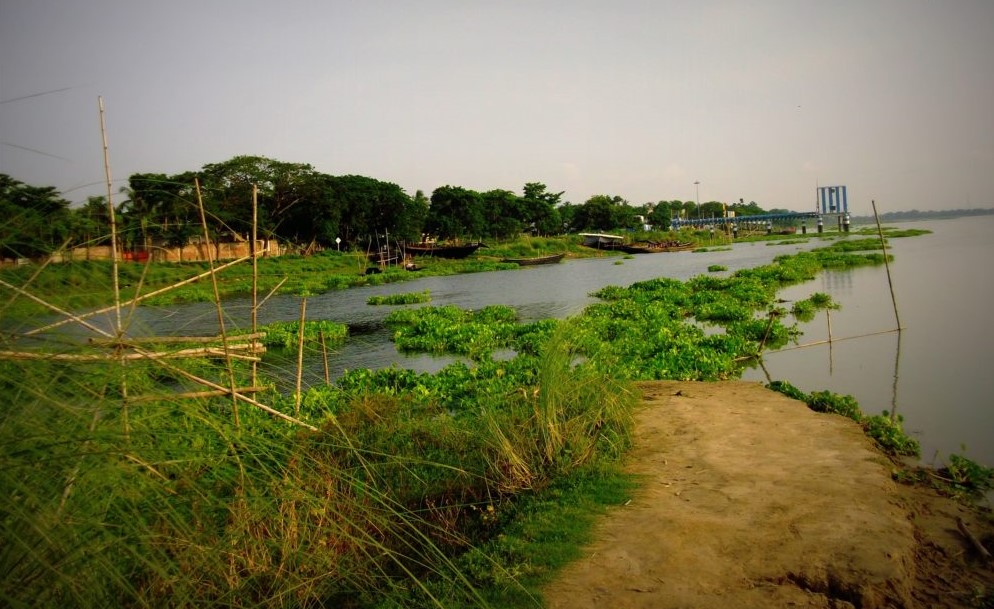
Confluence of Jalangi and Ganges Rivers at Svananda-sukhada-kunja in Mayapur
Then suddenly, he arrived one day and said:
By committing suicide I will not attain to the lotus feet of Lord Krishna. Nevertheless, I cannot tolerate anyone directly serving me.
Although requested hundreds of times to accept medicine, Srila Gaurakisora never consented. He always strictly followed Ekadasi without accepting even water. On days other than Ekadasi, he would often eat mud from the banks of the Ganges River, or cracked rice with dried peppers soaked in Ganges water. Because his renunciation was genuine, it gave pleasure to the Supreme Lord.
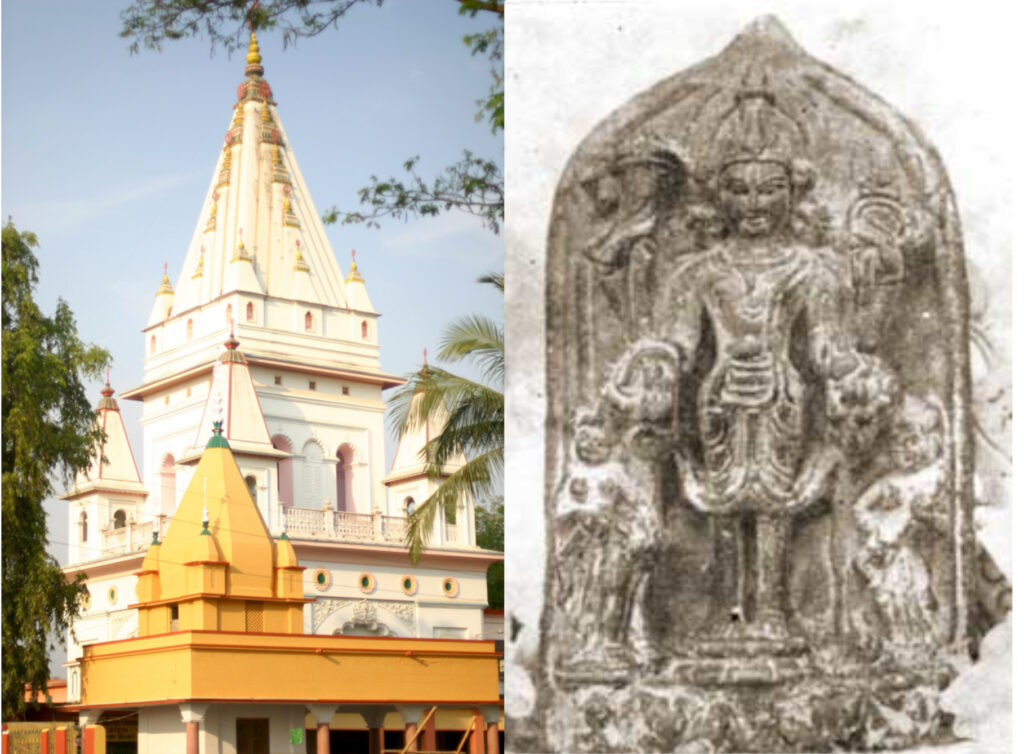
From 1903-1904, Srila Bhaktisiddhanta lived in Mayapur at the present-day Yoga-Pitha, where the Adhoksaja Vishnu Deity was uncovered when the construction of the Sri Chaitanya Matha began in 1895. This Vishnu deity was worshiped by Jagannatha Mishra, Lord Chaitanya’s father. Srila Gaurakisora would often spend much of his time there. This period was exemplified by the unique relationship shared by the spiritual master Srila Gaurakisora and his disciple, Srila Bhaktisiddhanta. Although apparently blind, Babaji Maharaja once arrived alone at Sri Mayapur at the Yoga-Pitha at two o’clock in the morning. Later that morning, Srila Bhaktisiddhanta, amazed to see his spiritual master, inquired:
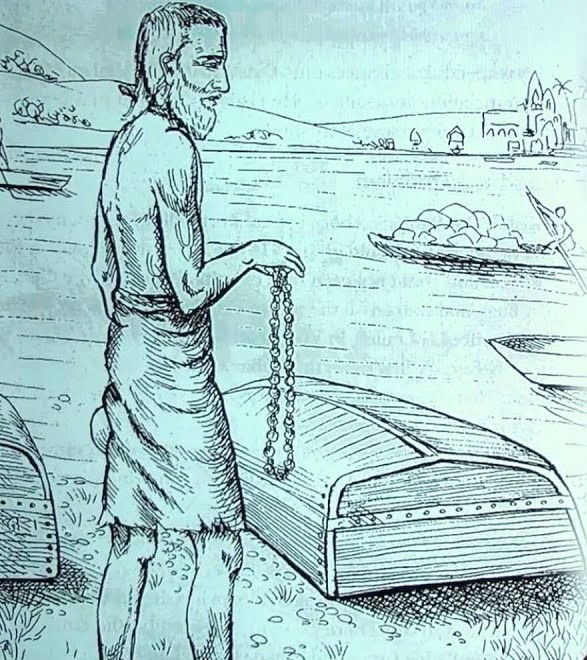
When did you arrive, Gurudeva?
Babaji Maharaja replied:
I arrived at about two this morning.
Astonished, Srila Bhaktisiddhanta asked:
Who brought you here last night? How did you find someone to show you the path?
Srila Gaurakisora replied:
Oh, someone showed me the proper way.
Srila Bhaktisiddhanta then said:
Externally, you appear to be blind. If someone had not brought you that long distance by hand, then how could you have come? Was it Krishna who brought you here last night?
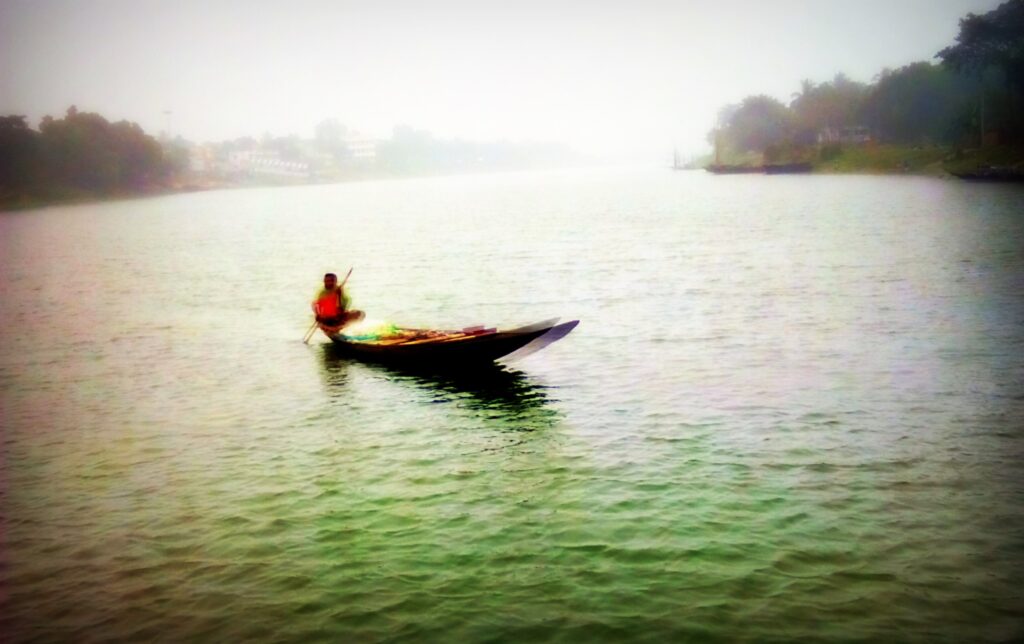
Confluence of Jalangi and Ganges Rivers
Hearing this, Babaji Maharaja could only smile. Srila Bhaktisiddhanta, sharing an internal relationship with his spiritual master, realized the purport of this exchange. In those days there were no footpaths to walk from Kuliya, on the opposite [western] side of the Ganges, to Mayapur, and no landing places for a boat. Srila Bhaktisiddhanta again inquired:
Who could have brought you across the river in the dead of night?
Srila Gaurakisora, in the same amused way, said:
One person took me across the river.
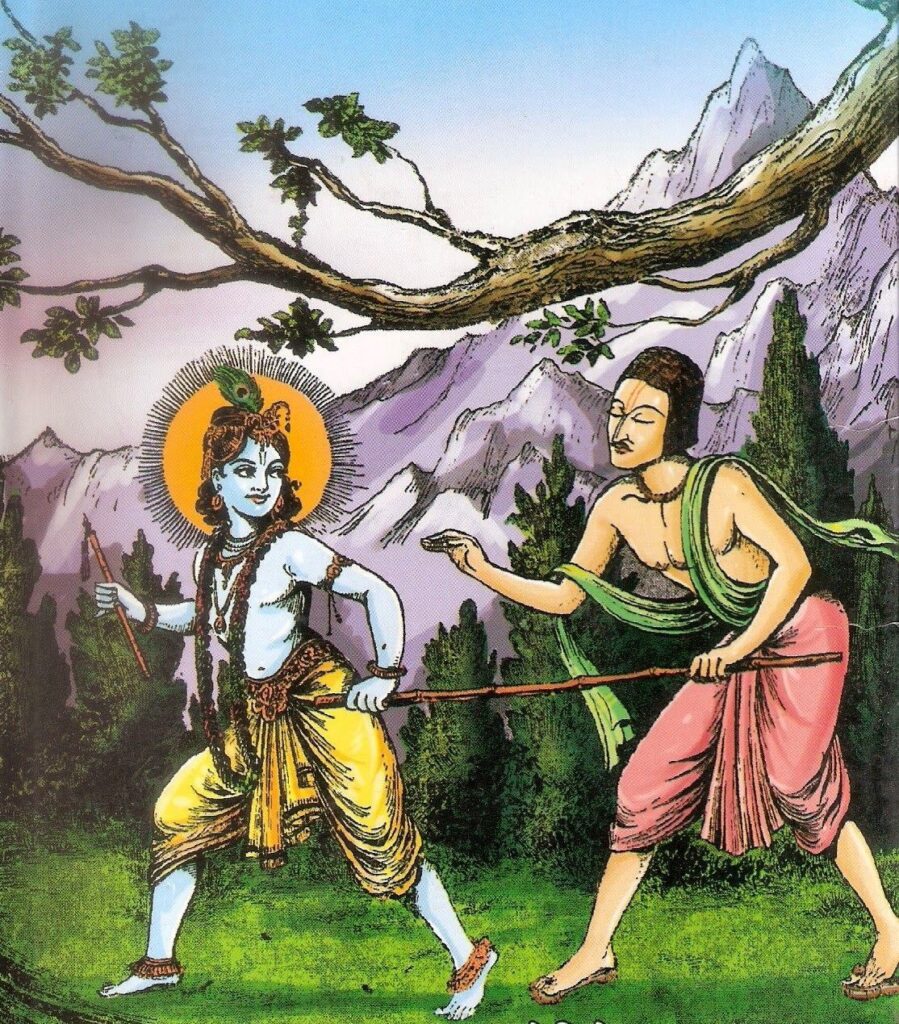
His disciple then realized that the person was none other than Lord Krishna, the son of Nanda Maharaja. This incident is reminiscent of Krishna guiding the blind Bilvamangala Thakur around Vrindavan. Around this time, for an entire month, Srila Bhaktisiddhanta explained the Sri Brihad Bhagavatamrtam of Srila Sanatan Gosvami at the Yoga Pitha. Srila Gaurakisora and other prominent Vaisnavas attended.
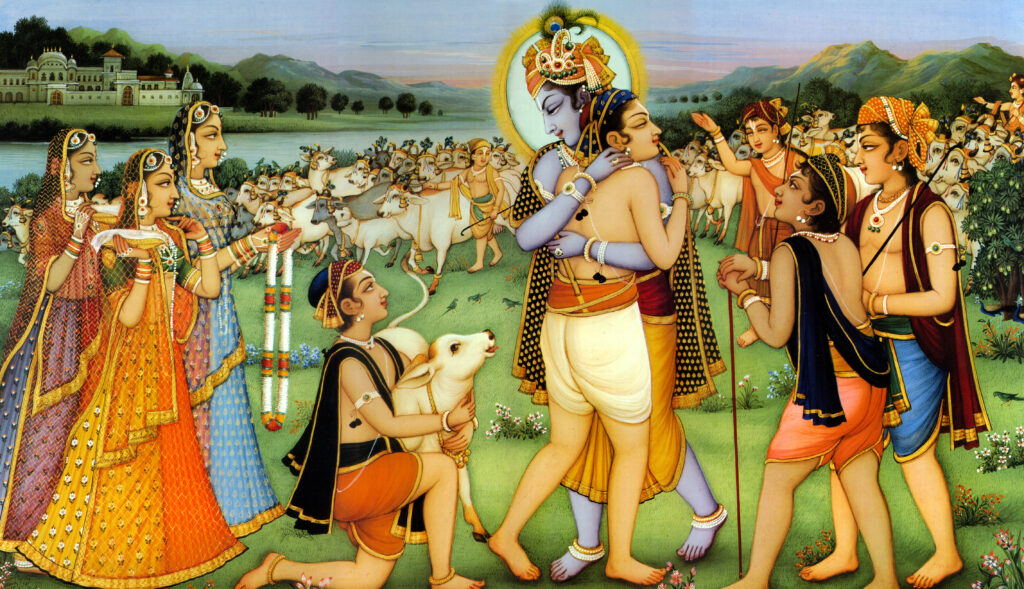
While Srila Gaurakisora was residing at a dharmsala [guest house for pilgrims] in the village of Kuliya, Srila Bhaktisiddhanta came and asked him many questions regarding the residents of Vrindavan and the various devotees who were performing solitary worship there. Srila Bhaktisiddhanta especially asked about the famous solitary worshipers who were considered to be perfectly realized souls in the estimation of the general public. Srila Gaurakisora laughed again and again at his query, and said:
They are all impostors.
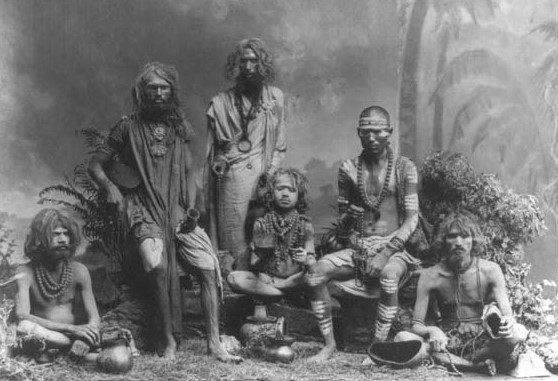
One babaji residing at Kusuma-Sarovara was renowned as a great bhajananandi. In addition, he even had one or two disciples who were reputed to be perfectly realized devotees. But Srila Gaurakisora did not even slightly recognize them as genuine babajis. After some time, the so-called exalted soul in Kusuma-Sarovara became afflicted with leprosy of the throat and died after extreme suffering. He lived in the holy dhama, but his behaviour was offensive because he pretended to be a great renunciate, but his mind was bent on sense enjoyment.
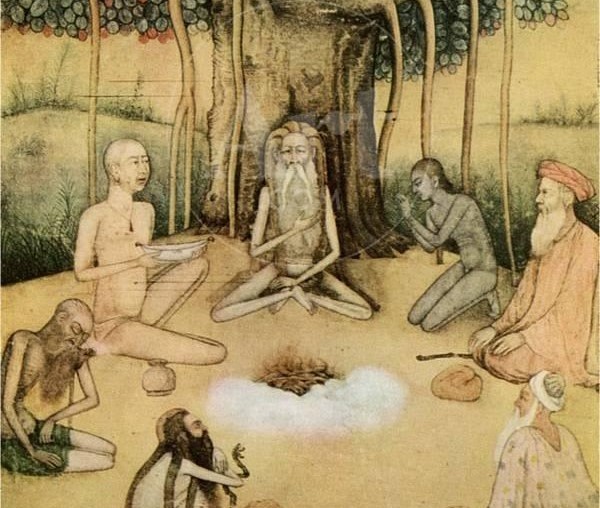
One day, a doctor, very anxiously desiring to stay in the holy dhama of Navadvipa and serve the Lord, came and revealed his intentions to Srila Gaurakisora. The young devotee had made arrangements to remain in the holy dhama as a doctor and treat sick persons. He planned to beg from the residents of Navadvipa, and with the profit, buy medicine. He would then be able to give free medical treatment. He considered that in this way he would perform his bhajan and at the same time perform the highest welfare activity for the community. To confirm his plans, he went to get the advice of Srila Gaurakisora. When he arrived and presented his proposal, he quoted the following verses spoken by Murari Gupta in the Caitanya-caritamrta (Adi Lila 10:50-51):
Srila Murari Gupta never accepted charity from his friends, nor did he accept money from anyone. He practiced being a physician and maintained his family with his earnings. As Murari Gupta treated his patients, by his mercy, both their bodily and spiritual diseases ceased.
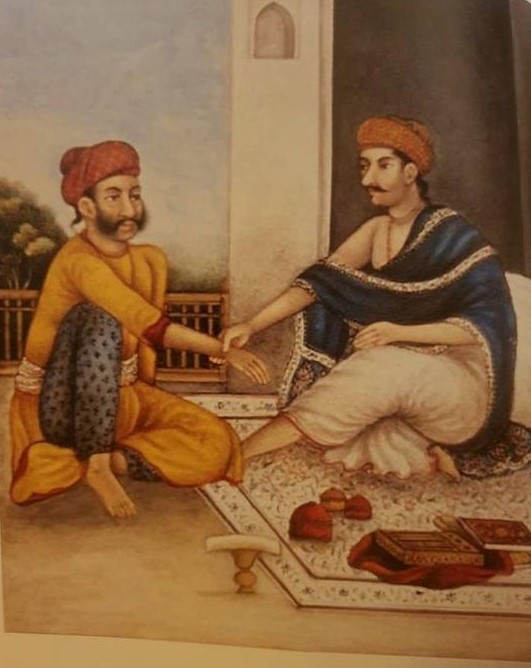
Srila Gaurakisora could understand the restless nature of the doctor and his inner motives for wanting to live in the holy dhama for his so-called devotional service. Srila Gaurakisora made this very evident to him when he explained:
Murari Gupta [an incarnation of Hanuman and Madhvacharya] is an eternal associate of Lord Chaitanya, and always lives in the transcendental world of Navadvipa Dhama. He never suggested any intentions of living in the Supreme Lord’s holy dhama by supporting himself through some clever means to materially enjoy there. He never supported his family at the expense of any temple, nor was he ever interested in earning money to keep his belly full. He would never accept charity or wealth from his friends or others.
He was a direct storehouse of love of Godhead, and by his mercy, anyone would obtain the mercy of Chaitanya Mahaprabhu. Whomever he treated would become cured from all disease and obtain loving affection unto the Supreme Lord. If one does not follow his exemplary lifestyle, but imitates his activities for sense indulgence in the name of pure bhajan, then one must eternally suffer the miseries found in the diseased state of material existence.
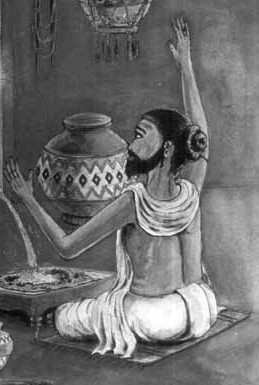
Murari Gupta
You are a patient suffering from the disease of material existence. How can you properly cure others? Crying, you must seriously pray for the mercy of Srila Murari Gupta. Then you will be able to understand what is the actual benefit for others. Sri Chaitanya Mahaprabhu simply taught that one should seriously chant the holy names of Lord Krishna. Anything contrary to that is less intelligent.
Just give up your bad intelligence and begin the process of hearing and chanting the glories of the Supreme Lord. If someone performs devotional service with other intentions, everything will be lost, including service to the Holy Name. Administering free medical treatment for worldly prestige and living in the holy dhama have nothing in common. A person who wants to enjoy the fruits of his activities can never actually live in the holy dhama.
Hearing the instruction of Srila Gaurakisora, the doctor asked, “Then what is my duty?” Srila Gaurakisora replied:
If you actually want to live in the holy dhama, you should first completely give up this idea you are entertaining. Abandon the misconception that benefiting materialistic persons by distributing free medical treatment is favourable for your worship. Any services you offer, or any religious practice which is not in connection with saintly persons who are factually performing bhajan, will be the cause of deep material bondage. As of now, it would be better if you returned home and chanted the Holy Name and maintained your livelihood. If this is what you really want then go home. Don’t deceitfully maintain yourself in the holy abode of Navadvipa by some clever means.
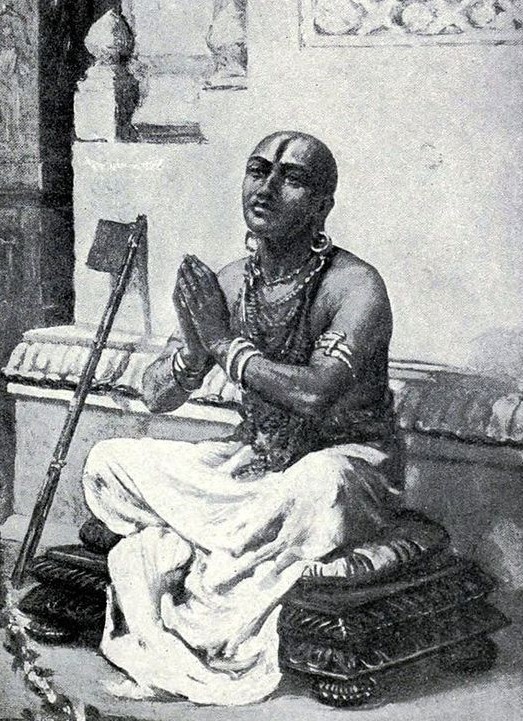
A new devotee who had just taken up the dress of babaji would often come and talk with Srila Gaurakisora. Finally, he decided to live in the holy dhama, and so he approached a female zaminder [landowner] to purchase three-quarters of an acre of land. After hearing this, Srila Gaurakisora said:
The supreme abode of the Lord is transcendental. How is it possible that this queen has become the owner of the holy dhama? How is it that she is entitled to sell that new babaji a portion of land in the holy dhama? All the jewels within the universe are not valuable enough to purchase even one speck of dust from the holy dhama. So how can any landowner amass enough wealth to become the owner of a plot of the transcendental abode of Sri Navadvipa Dhama?
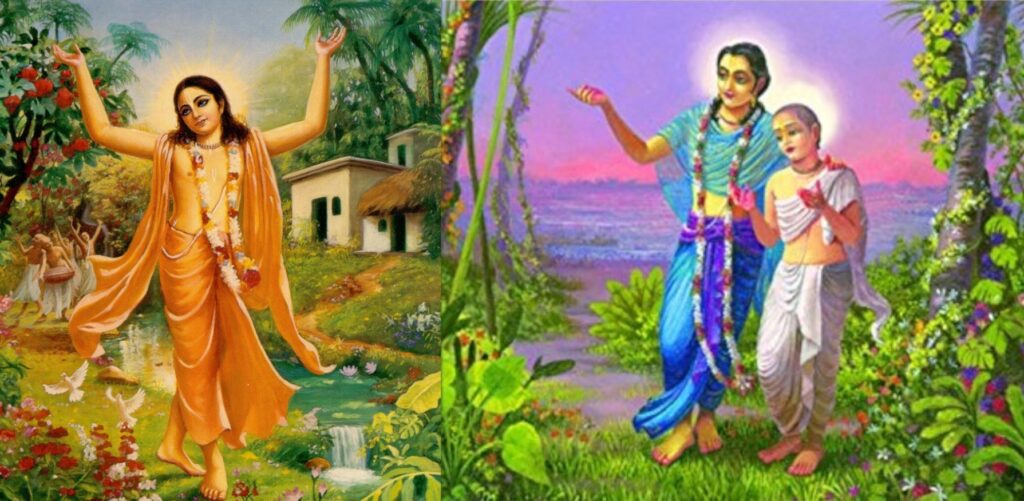
Has this new baba, by the exchange of his devotional magnanimity, become entitled to a portion of land in Navadvipa Dhama? Let anyone who has such a materialistic mentality remain living at a distance from the holy abode. An attitude like that will certainly be offensive. Anyone who thinks the holy dhama is material is considered by the true devotees of the Supreme Lord to be a prakrta sahajiya or cheap impostor.
Without love for Krishna, outward displays of knowledge or detachment simply create false prestiege to feed the false ego and mislead others. This is nicely explained in Srimad Bhagavatam:
By rendering devotional service unto the Personality of Godhead, Sri Krishna, one immediately acquires causeless knowledge and detachment from the world.
In his purport to this verse, Srila Bhaktivedanta Swami explains:
… one who is a pure devotee has all other good qualities, namely knowledge, detachment, etc., but one who has only knowledge or detachment is not necessarily well acquainted with the principles of the bhakti cult. Bhakti is the supermost occupation of the human being.
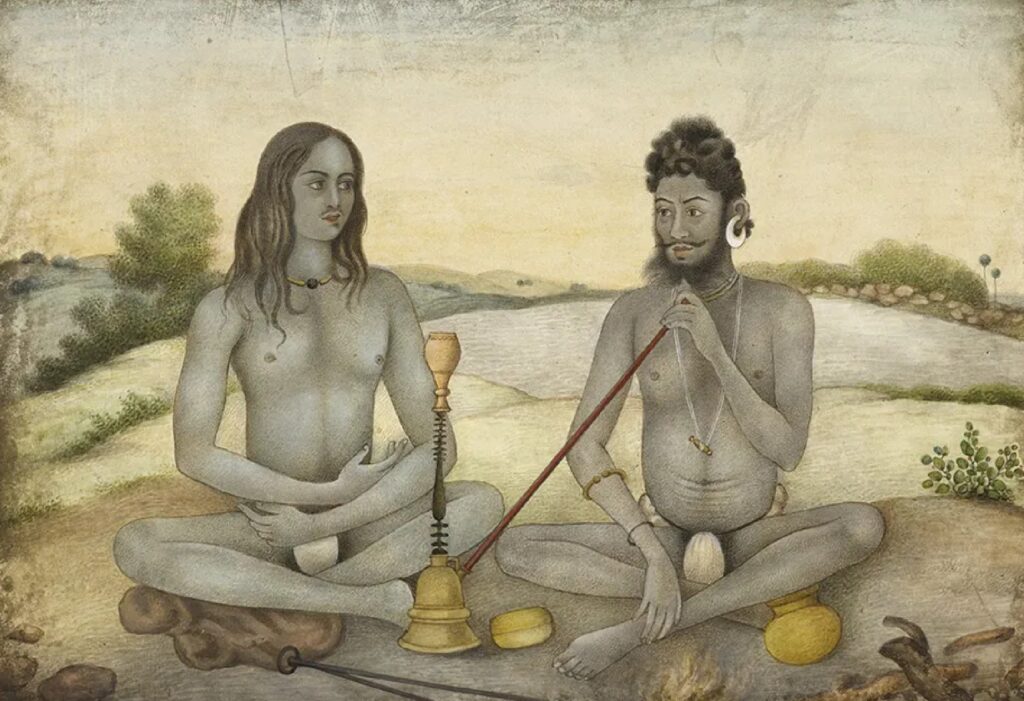
Pretend impostor babajis
One day a resident of East Bengal [now Bangladesh] who was a very wealthy landlord, came with his friend to see Srila Gaurakisora. He was a brahman and was recognized as a learned scholar and great devotee of the Lord. This landowner was apparently so deeply absorbed in devotional ecstasies that his friend had to assist him by holding him as he walked. When they arrived before Srila Gaurakisora, the landowner was holding the shoulder of his friend in order to walk as his body was trembling in apparent ecstasy. Several of the assembled devotees recognized the landowner and knew he was respected as an advanced devotee in the devotional community. The devotees very reverently arranged a sitting place for the visitor and requested him to please be seated.
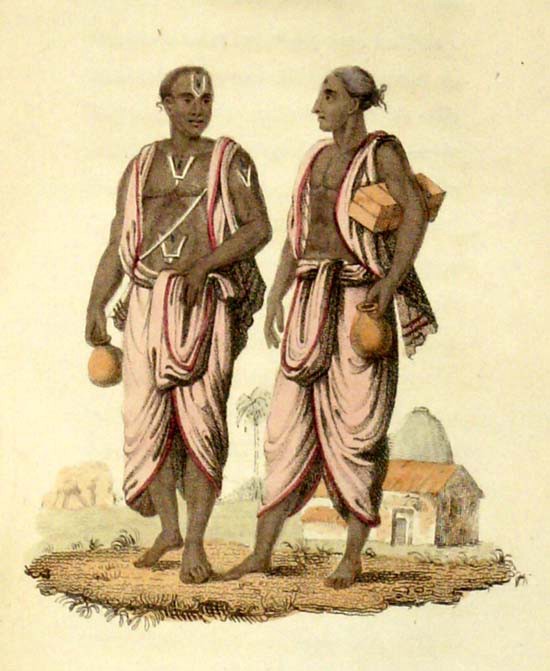
At that time Srila Gaurakisora was enacting his divine pastime as a blind person. When he heard the devotees respectfully greeting the visitor, he asked, “Who has come?” The landowner’s friend introduced his companion by elaborately describing his erudition, devotion, and non-attachment to the material world and its temptations in spite of him possessing unlimited wealth. He then described how only one fortnight before, a thief had broken in and stolen forty-five thousand rupees from the landowner’s house. Although suffering such a setback, the landlord, knowing that devotion should be one’s ultimate attachment in life, had come for Srila Gaurakisora’s divine association. The friend added:
I am his only friend. He has left all other material association and now only associates with me. You will be able to realize his greatness just by talking with him. He once asked me a question about a confidential exchange between Sri Chaitanya Mahaprabhu and Sri Ramananda Raya from the Caitanya-caritamrta. I told him that only you, Srila Gaurakisora, could properly answer his questions. We have already been to see many scholarly persons in Navadvipa, yet we cannot come to any agreement regarding the inner meaning of this conversation. We think that only you can explain it properly.
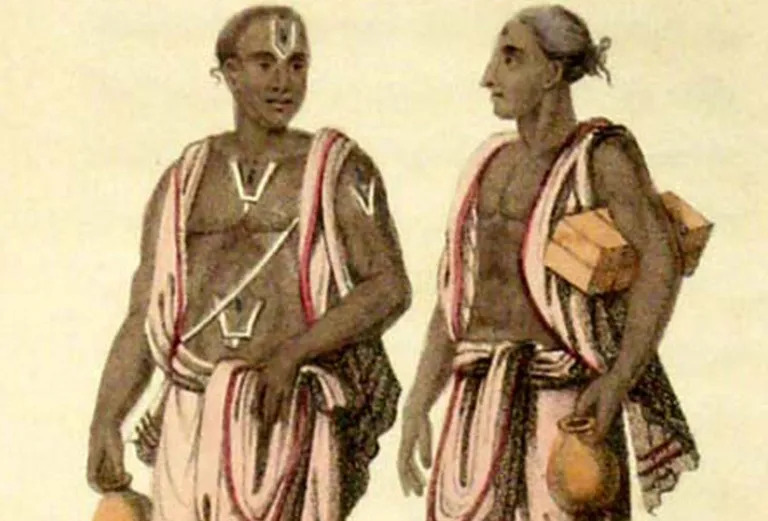
After the friend of the great devotee completed his introduction, Srila Gaurakisora replied:
I will tell you how you can understand the conclusion of this conversation. But before trying to understand these confidential topics between Lord Chaitanya and Ramananda Raya, you should renounce the association of this rascal impostor landowner and take shelter of a pure devotee of the Lord. You should hear the Caitanya-caritamrta one hundred times from beginning to end in the association of advanced devotees of the Lord. In this way, crying and being absorbed in devotional ecstasy, you will be able to realize the purport of these conversations. At present all the devotees here want to congregationally chant the Lord’s holy names. We don’t have time to discuss anything else.
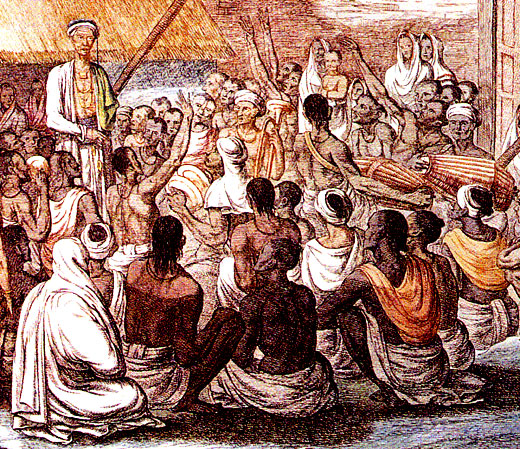
Then Srila Gaurakisora loudly requested that everyone perform Hari Nama Sankirtan. Everyone began to chant the holy name of Krishna. After hearing this, the landowner and his friend immediately left. Later that evening, when almost everyone had left, one or two persons told Srila Gaurakisora:
That very learned landowner was so absorbed in devotional ecstasy that we saw no trace of wordly consciousness in him.
Another person sitting nearby also spoke up in defence of the landowner:
That person was so immersed in various loving devotional ecstasies that he could not even walk by himself. How can you say he was not on the highest level of Bhava-bhakti?
Srila Gaurakisora then replied:
After speaking with him a few moments, I could understand that he had no good intentions in his performance of devotional service. One cannot measure a person’s devotional advancement by the popular vote of ordinary people. If a person is not serious in his devotional practice, then even if he displays external signs of renunciation, material indifference, or ecstatic symptoms in spontaneous devotion, he should not be considered to be actually renounced and experiencing devotional moods. As soon as a difficult test comes, false renunciation will not endure. At the first opportunity, detachment searches out the shelter of practitioners who are seriously fixed in their intentions to execute devotional service. In our practical devotional service, we never show anyone our devotional ecstasies.
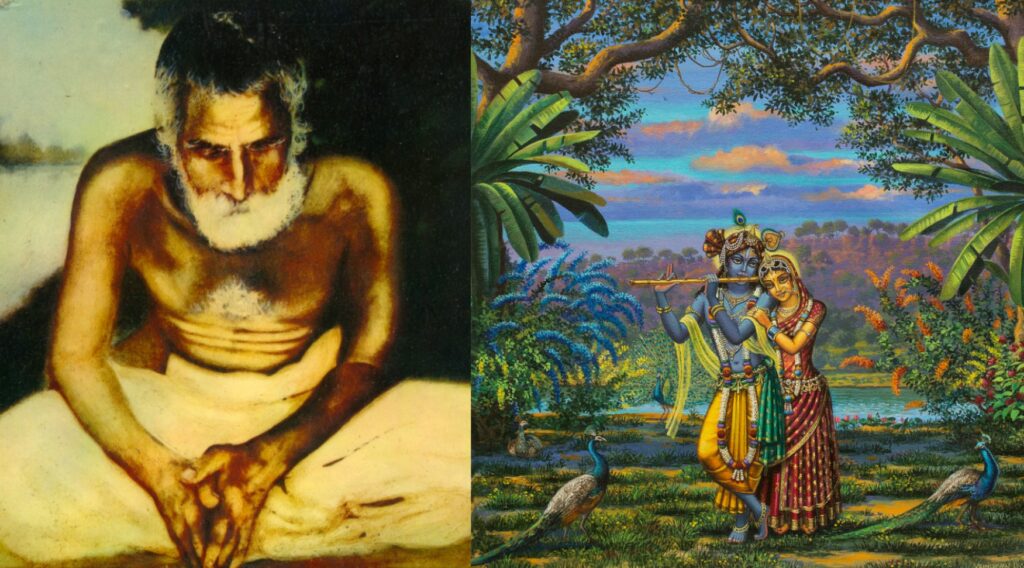
One should perform devotional service in such a way that deep attachment to the Lord will internally blossom in the heart. Even if one makes an external show of symptoms of attachment to the Lord, he will not receive the Lord’s causeless mercy if he does not actually develop internal loving attachment. When there is an actual deep loving attitude, Krisnha Himself will approach the advanced devotee. A person who lacks even a trace of sincerity and unflinching devotion, and whose heart is filled with material desires, simply decorates himself with some nice dress. Krishna remains proportionally aloof or available according to the degree of one’s surrender.
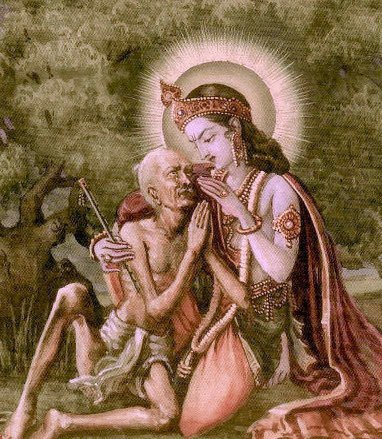
On the other hand, if one is spontaneously immersed in devotional attachment to Lord Hari, then even if he externally appears to be suffering from leprosy, Krishna becomes spiritually overjoyed by the slightest trace of his transcendental loving service. When we can fast and chant Hare Krishna day and night, always crying out for the service of Srimati Radharani without offering any external show to others, then Sri Krishna, who is the very wealth of Srimati Radharani’s life force, can be captured.
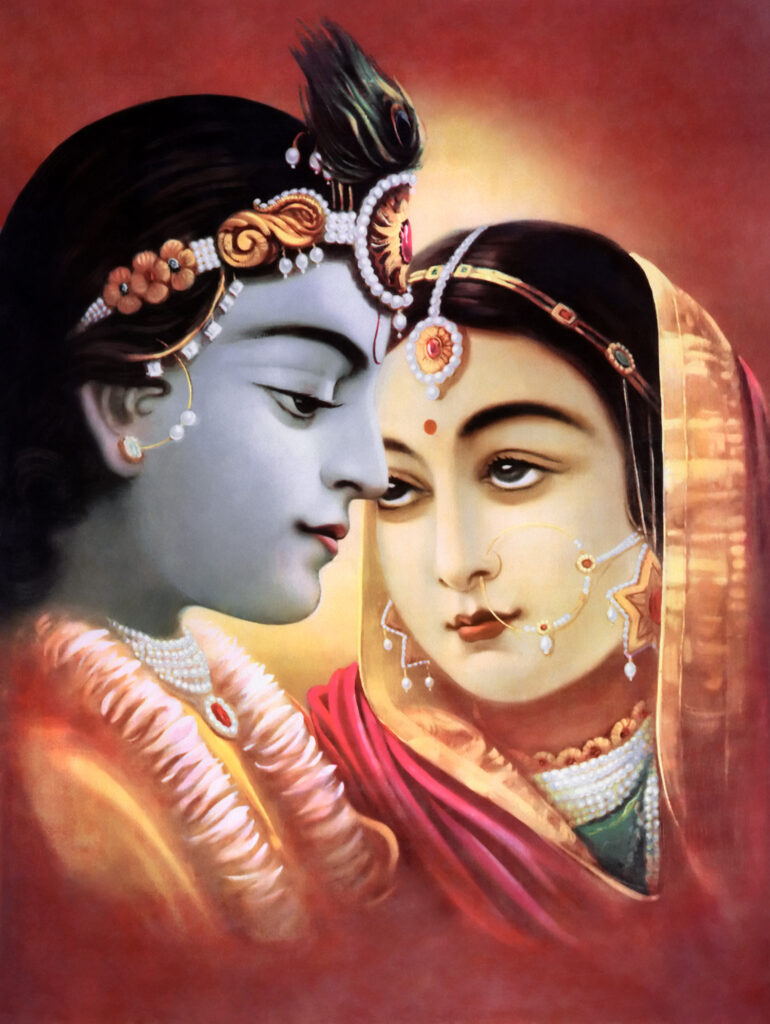
One day, a few devotees were describing the expertise of a particular lecturer on the Bhagavat. Babaji Maharaja knew that this individual received money for his services. He said:
This fellow does not explain the Bhagavat or the scriptures of the Goswamis. He is simply speaking on the sense-gratification scriptures. He isn’t chanting ‘Gaura, Gaura!’ or ‘Krishna, Krishna!’, but ‘Money! Money!’ It has nothing to do with bhajana. The end result is that the true Vaishnava religion is obscured. Nothing good can come from it; indeed, the world will be harmed by such preaching.
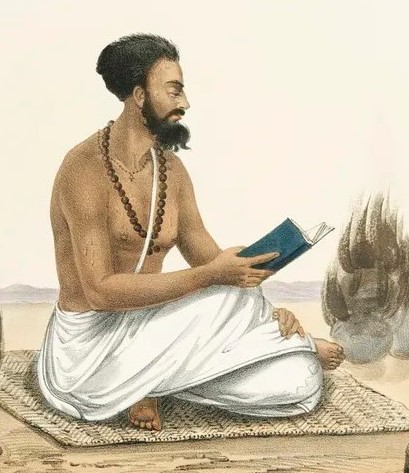
One day Babaji Maharaja was chanting japa late at night when he suddenly jumped up and exclaimed:
Did you see that? Did you see? A professional speaker on the Bhagavat has gone to Pabna district and has just made a chaste widow break her vows! What a shame! These rascals are giving Mahaprabhu’s religion a bad name.
He spoke as if he were personally witnessing the event.

One day during the cold season, a devotee made a gift of a quilt to Babaji Maharaja, but rather than wrapping himself in it, he simply draped it over the tiny bamboo shelter under which he slept. When asked why he did that, he answered that the cold would go away simply upon seeing the quilt.
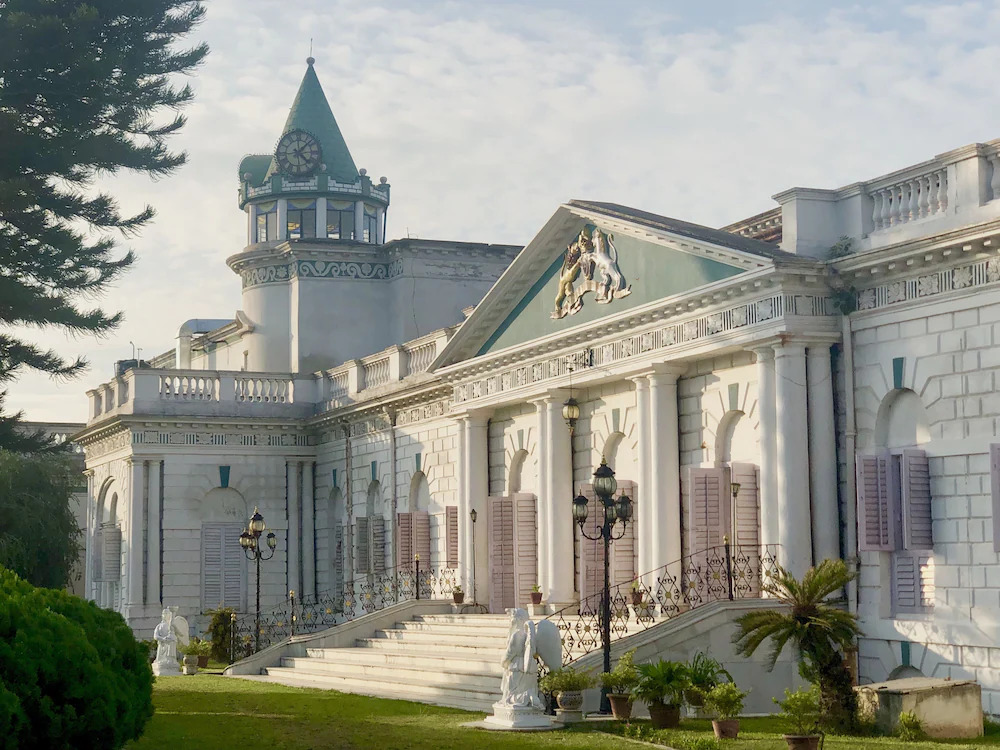
Cossim Bazar
One day the Raja of Cossim Bazar, Sir Manindra Chandra Nandi Bahadur, invited Babaji Maharaj to his palatial residence for a Vaisnava assembly. Babaji Maharaja answered:
If you want my association, leave all your riches and come and live under a bamboo shelter like mine. You won’t have to worry about food. I will beg for enough to feed both of us. If I go to stay in your palace, it won’t be long before I start desiring to enjoy sense gratification. I will start thinking about how I can accumulate a property for myself. Then before you know it, I will become your enemy. If you want to preserve our friendship and if you wish to be kind to me as your Vaisnava friend, then you will come to the Dhama and join me in worshiping the Lord and eating madhukari [food obtained from begging].
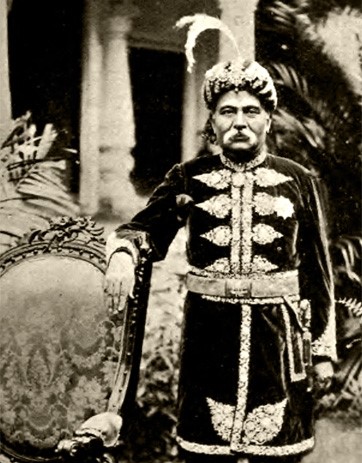
Maharaja Manindra Chandra Nandi
Gaurakisora das Babaji Maharaja’s mood of renunciation was extraordinary, and said to meet the standard of Srila Rupa and Raghunath Goswami’s renunciation. Completely detached, he would wash discarded cloth to cover his body. He drank from a rejected clay pot. He ate parched rice mixed with Ganges water or simply some mud from Ganga’s bank or the banks of Radha-Kunda or the Yamuna. He saw all the Vrajavasis [residents of Vrindavan] as being the direct personal associates of Radha and Krishna. As a result of this vision, he would pay respects to every person, cow, animal, bird, tree, creeper, insect, ant in the holy dhama. In Navadvipa, he used to sing one bhajana which means:
By receiving Nitai’s mercy one gets Gauranga’s mercy, which makes one eligible for Krishna prema. With Krishna prema one can attain the service of Srimati Radharani and the gopis.
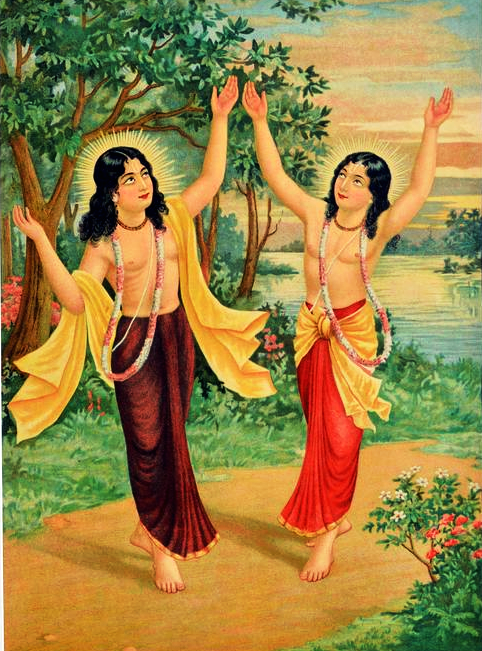
Regularly, he heard Srimad Bhagavatam from Srila Thakur Bhaktivinoda in Godrumadvipa, relishing his association. Constantly absorbed in bhajan, Srila Babaji Maharaja had no desire to make disciples. However, on the request of Bhaktivinoda Thakura, he reconsidered. Upon seeing the true humility and deep attachment of Thakur Bhaktivinoda’s son for bhajan, Srila Gaurakishora Das Babaji accepted one disciple – Srila Bhaktisiddhanta Saraswati Thakur. In January, 1900, Srila Gaurakisora initiated Srila Bhaktisiddhanta in Svananda-sukhada kunja. [The story of Bhaktisiddhanta’s initiation will be covered in the upcoming post on Srila Bhaktisiddhanta Sarasvati.]
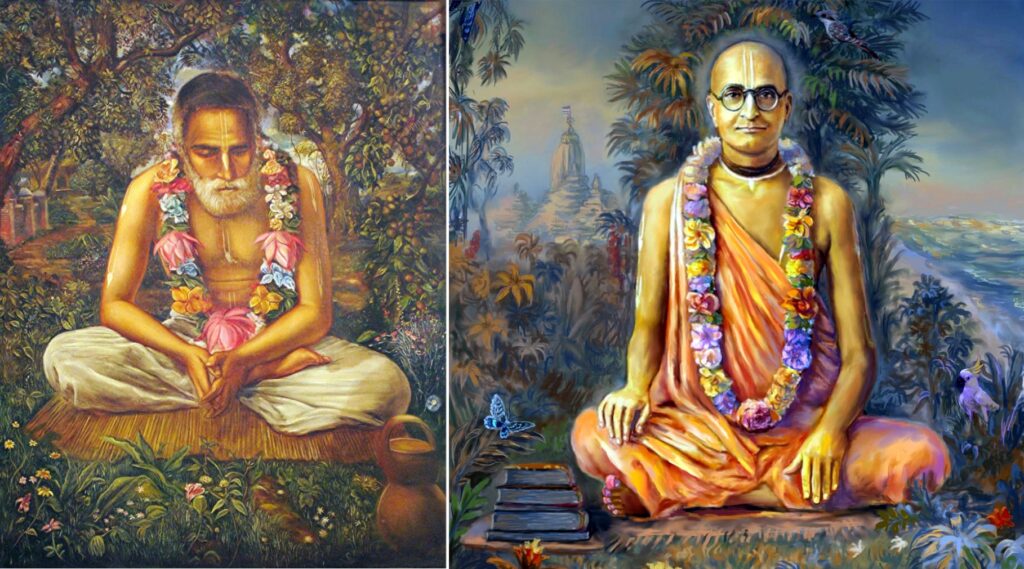
Becoming Srila Bhaktivinoda Thakur’s Vesa Guru
Srila Bhaktivinoda Thakur gave up household life and accepted initiation into the renounced order from Srila Gaurakisora Das BabajI Maharaj. One day in 1908 the Thakur followed the BabajI as he went from the Thakur’s house in Godrumadvipa to the boat ghata, where he would cross the Ganges and go to Navadvipa. As he followed him, the Thakur repeatedly asked him to give him initiation into the renounced order of life as a babaji. Gaurakisora Das Babaji felt that he was very fallen and unqualified, seeing the Thakur as his spiritual master, and thus, with great humility, he refused to become the Thakur’s vesa guru.
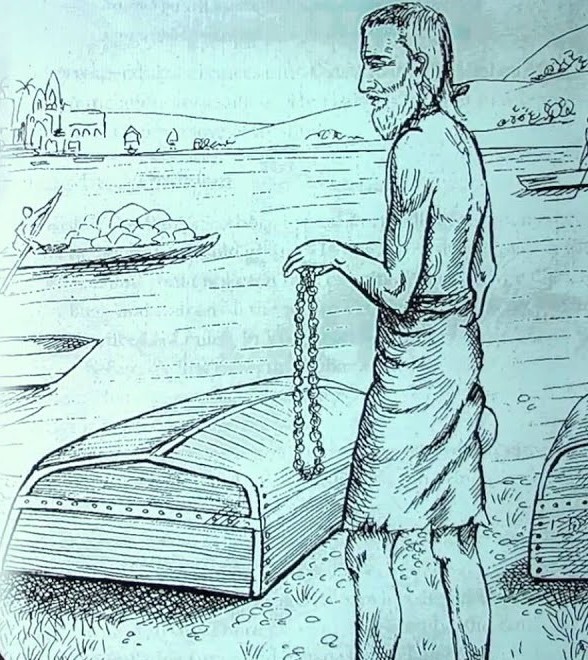
Soon after this, the Babaji, by mystic intuition, could understand that the Thakur was very determined and was coming to Navadvipa to ask him again. In order to avoid him, the elderly Babaji went to the house of a known prostitute, near a marketplace in Navadvipa, and sat on her veranda for a while. He reasoned that if he had gone anywhere else, he would have been discovered by the Thakur. But he would never be found in the house of a prostitute, for the Thakur would never enter such a place.
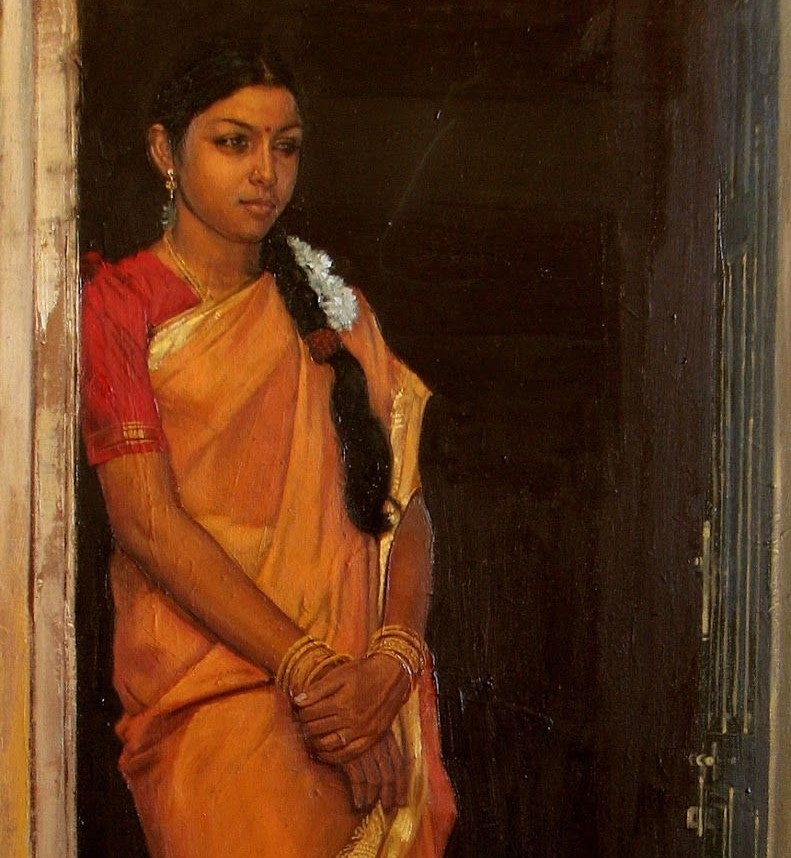
Meanwhile, the Thakur, not finding Babaji Maharaj, could understand his uneasiness, and so he returned to Godruma. Babaji Maharaj then came out of hiding and went to the Radha-ramana Gardens, where he began to laugh uproariously. When questioned by a devotee who was present as to why he was laughing so much, he replied:
Today I have outwitted Kedaranatha Babu. I sat in that mataji’s house over there and not being able to find me, Kedaranatha Babu returned home.
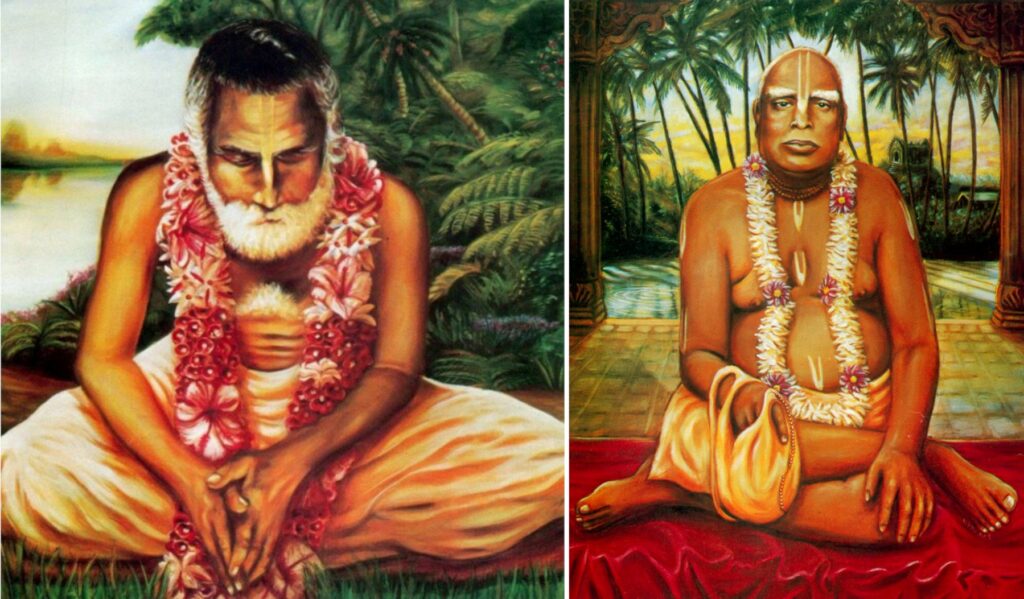
A few days later, the Thakur sent one of his sons to Navadvipa to bring BabajI Maharaj to Svananda-sukhada-kunja. The Babaji agreed to come, and after staying for a few days, he consented to initiate the Thakur as a babaji. According to Gaurakisora Das Babaji Maharaj’s direction, the Thakur, in his presence, put on the old loin cloth and bahirvasa (begging apron) of Srila Jagannath Das Babaji, his siksa-guru, who had departed from the world some years earlier. By his verbal consent and his physical presence as a witness, Srila Gaurakisora Das Babaji Maharaj became the vesa guru of Thakur Bhaktivinoda.
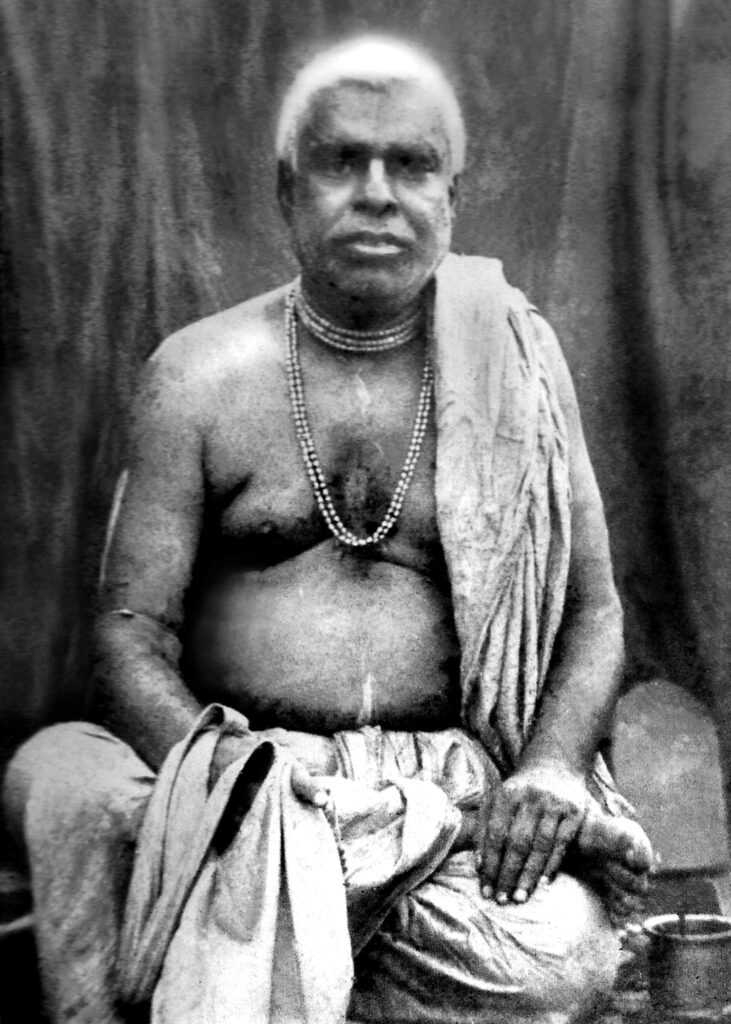
To keep mundane people from approaching him for material boons, Srila Gaurakisora Das Babaji once resided in the lavatories at the Kuliya Dharmasala [in Navadvipa]. The owner of the Dharmasala was a certain Girisha Babu. One day, his wife offered to build a cottage for Babaji Maharaj. He answered:
I have no problem sleeping under the straw shelter on a boat. The only problem I have is that so many rascals are constantly coming to me asking me to bless them. They disturb my chanting. They don’t really want my blessings because they don’t really want what is best for them, but still they come to disrupt my chanting the Holy Name. If you give me your brick outhouse, I will be able to chant in peace. No one will come to bother me there.


Ganges boats were traditionally built with a straw shelter
When he realized that Babaji Maharaja was serious, Girisha Babu immediately had the outhouse purified with cowdung and brought in a mason to completely redo the building. When public officials came offering to build him a proper bhajan kutir, Babaji Maharaja locked himself inside and said he already had one.
Babaji Maharaja spoke gravely to a newly married man:
A Vaisnava wife is extremely rare and difficult to find in this world. If one has the good fortune of having one, he should see it as a benediction from Krishna. The wife worships the husband as her lord and master. Similarly, the husband should worship the wife because she is Krishna dasi, a servant of Krishna. In this way, the husband can protect his devotional enthusiasm by not considering his wife to be his maidservant, but she is always the maidservant of Krishna.
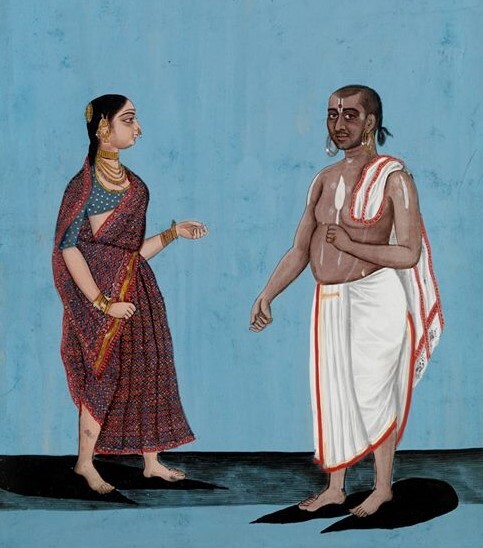
The essence of Srila Gaurakisora Das’ instructions was:
The Divine Name of Krishna offers the one and only shelter. One should never try to remember Radha-Damodara’s transcendental pastimes by artificial methods. Constant chanting of the Divine Names will purify the heart. By chanting Hari Nama the syllables of the Maha-mantra [Hare Krishna Hare Krishna Krishna Krishna Hare Hare, Hare Rama Hare Rama Rama Rama Hare Hare] will gradually reveal the spiritual form, qualities and pastimes of Sri Krishna. Then you will realize your own eternal spiritual form, service, and the eleven particulars of your spiritual identity.
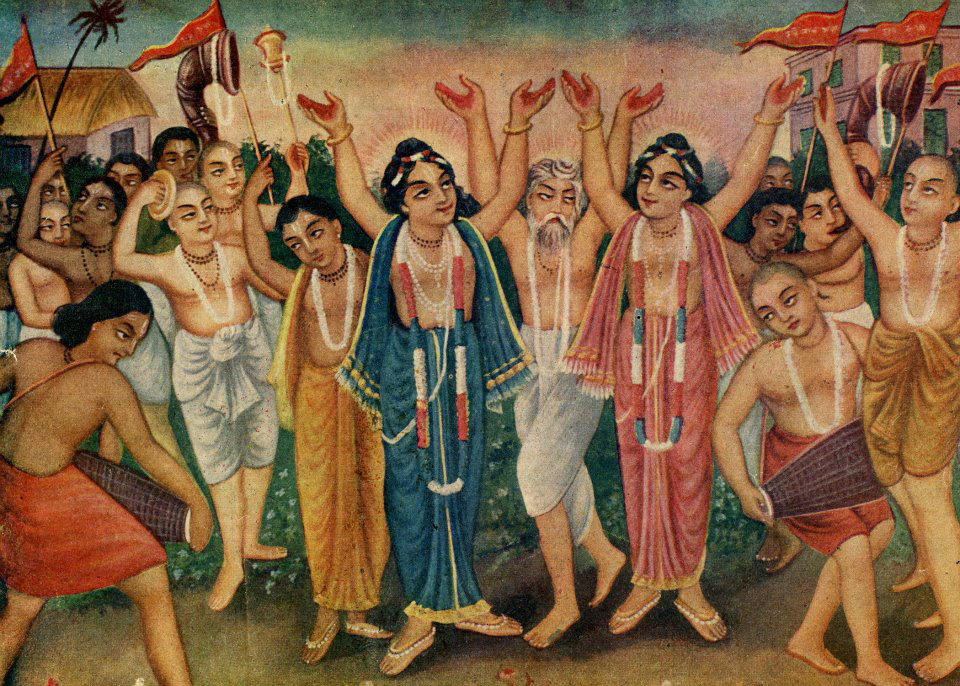
On November 16, 1915, Srila Gaurakisora Das Babaji entered the eternal pastimes of the Lord. Bhaktivinoda Thakur had departed the previous year. The Babaji Maharaja had been staying at Kuliya Dharmasala and when Bhaktisiddhanta Sarasvati arrived from Mayapur, the head priests of Navadvipa’s various temples and ashrams were heatedly arguing among themselves about where Gaurakisora’s body would be interred. They considered that establishing the Babaji’s samadhi at their ashram or temple would enable them to earn handsomely from the pilgrims who would flock to see the tomb of such a great saint. Bhaktisiddhanta Sarasvati, seeing through their evil motivations, opposed their efforts to take charge of the body.
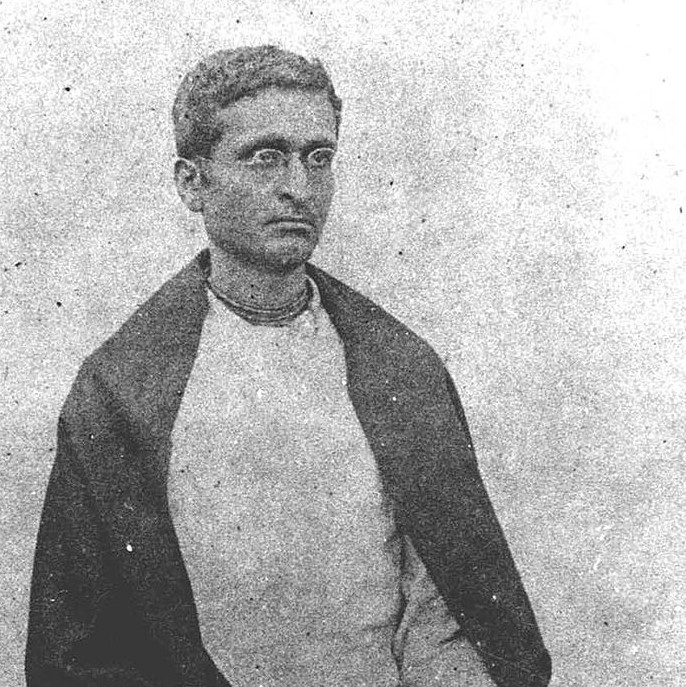
In the presence of Navadvipa’s Police Inspector, the hypocritical so-called holy men argued:
Srila Sarasvati Thakur is not a sannyasi and thus has no right to prepare a samadhi for a person who has renounced his home.
Bhaktisiddhanta Sarasvati Thakur replied in a voice like thunder, saying:
I am the sole disciple of Paramahamsa Babaji Maharaja. Even though I have not accepted sannyasa, I am a celibate brahmachary, and by the grace of Babaji Maharaja, I am not a hypocritical renunciate secretly addicted to abominable habits or fornication as some monkey-like people are. I take pride in saying this as a bearer of Babaji Maharaja’s shoes.
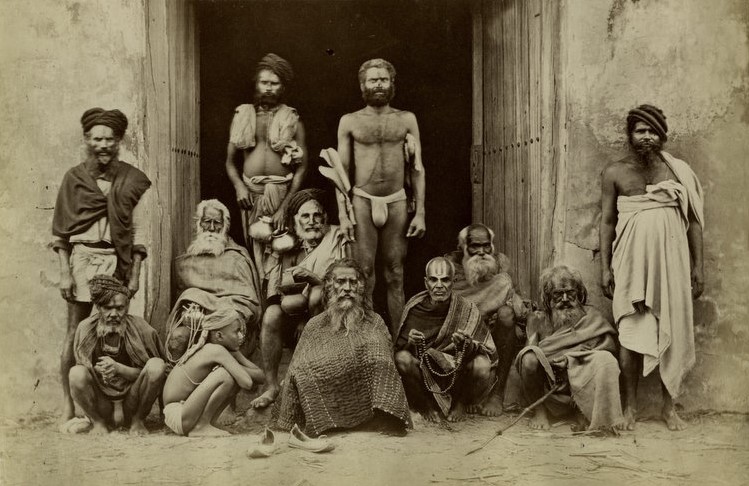
If there is someone here who is a renunciate of truly stainless character, then he can come forward and arrange for the samadhi. I have no objection to that. He who within the last one year, or six months, three months, one month or even three days has not indulged in illicit association with women will be able to touch this spiritually blissful body. If anyone else touches it he will be completely ruined.
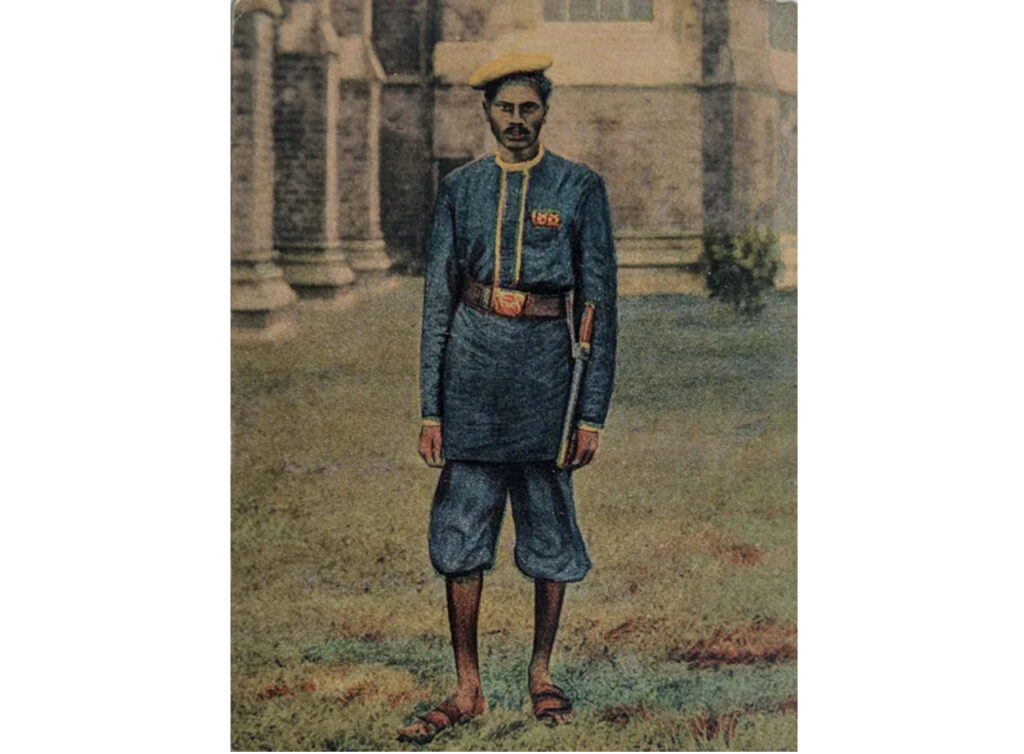
Hearing these words, the Inspector of Police said:
How will the evidence for this be produced?
Srila Sarasvati Thakura replied:
I will believe what they say.
But after this challenge was offered, the Babajis turned their backs one by one and departed from that place. The Inspector of Police was dumbfounded. Some of the people remaining there advised that Gaurakisora Maharaja had expressed a last desire that his body be dragged through the streets of Navadvipa in the dust of the Holy Dhama.
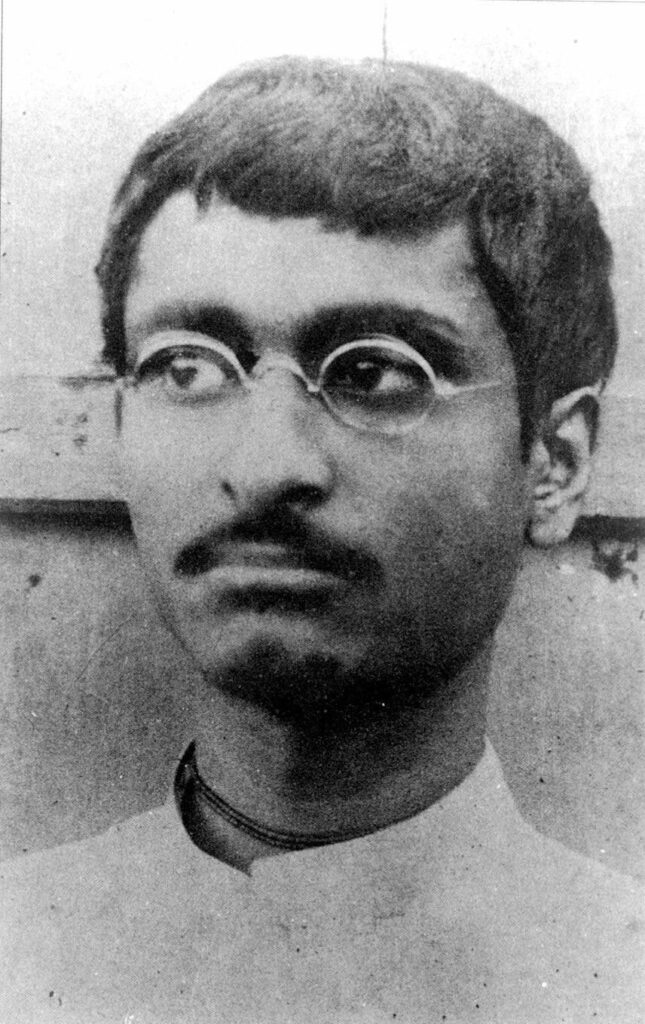
To this, Bhaktisiddhanta replied:
Although we are fools, inexperienced and offenders, we will still not be disinclined to understand the true meaning of those humility-filled words, which have been spoken by my Gurudeva to destroy the pride of worldly-minded people. Even Krishna-candra will personally think Himself successful if He carries my Gurudeva on His head or shoulders. After the departure of Haridas Thakur, Sri Gaurasundar took the spiritual body of the Thakur on His lap and danced. What dignity He adorned it with! Therefore, following in the footsteps of Sriman Mahaprabhu, we shall also bear Babaji Maharaja’s spiritually blissful body on our heads.
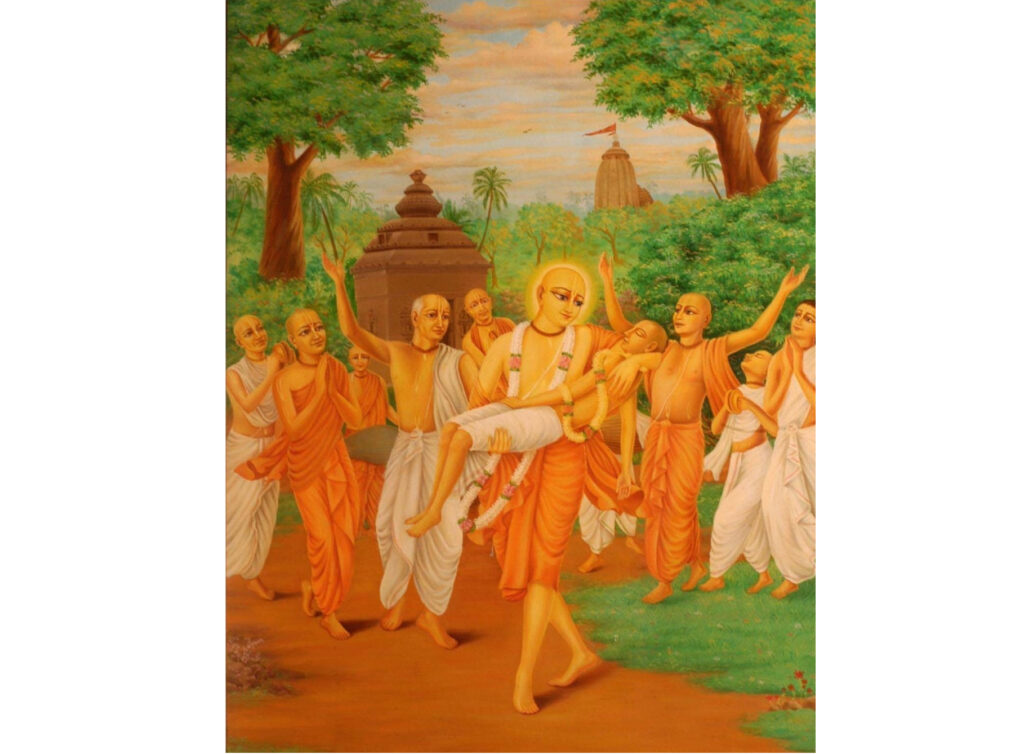
On the following day, Srila Sarasvati Thakur laid the body of his guru to rest on a sandspit of the Ganges at Kuliya. Sixteen years later, due to erosion from the River Ganges, Srila Bhaktisiddhanta Sarasvati Thakur had the samadhi moved to a site on the banks of Sri Chaitanya Math’s Radha-Kunda, near Lord Chaitanya’s Yogapitha in Sridhama Mayapur.
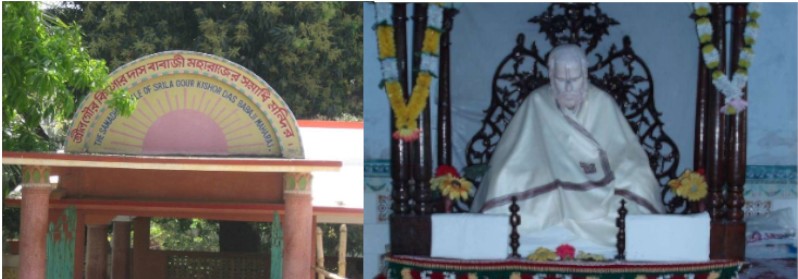
Samadhi Temple of Gaurakisora Das Babaji
Gaurakisora Das Babaji’s Favourite Song
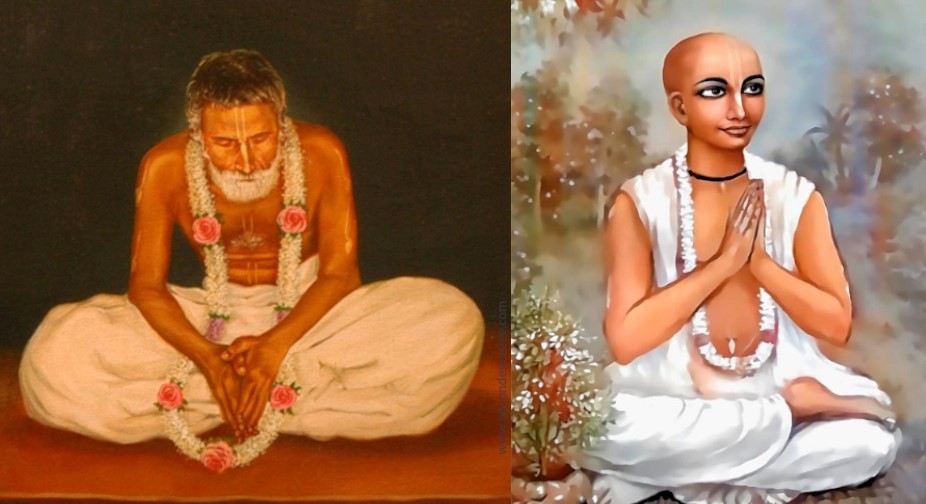
Narottama Das Thakur’s songs were much beloved of Gaurakisora Das Babaji Maharaj. He was often heard to sing one of them in particular. All the Vaisnava teachings can be found in this one song:
gaura pahu na bhajiya goinu
prema-ratana-dhana helaya harainu
adhane yatana kari dhana teyaginu.
apana karama-doshe apani dubinu
sat-sanga charii kainu asate vilasa
te-karane lagila je karma-bandha-phansa
vishaya vishama visha satata khainu
gaura-kirtana-rase magana na painu
keno va achaye prana ki sukha lagiya
narottama dasa kena na gela mariya
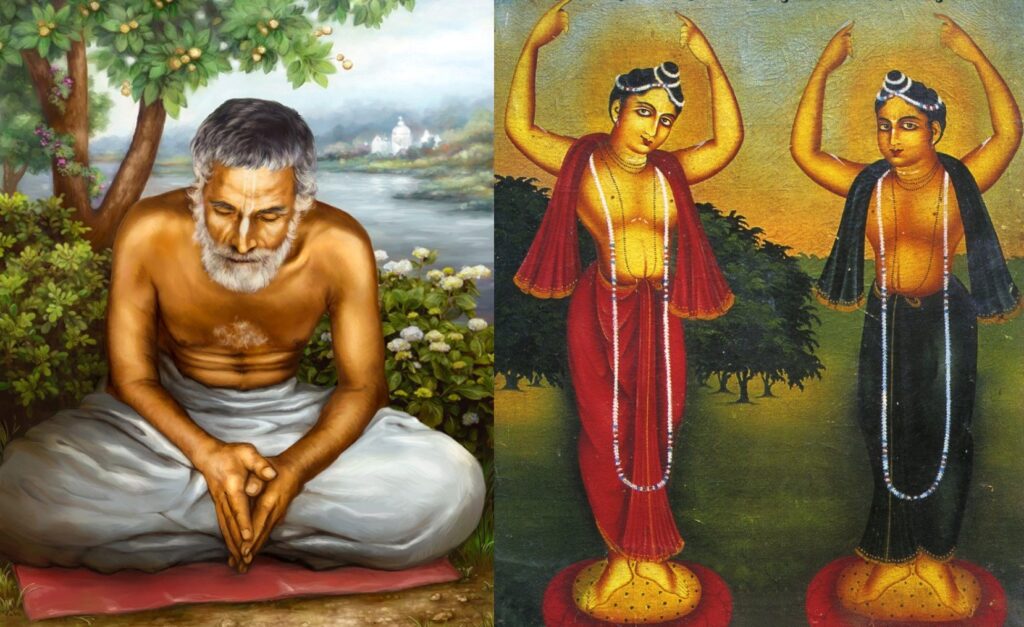
Translation:
I have invited my spiritual death by not worshiping Lord Chaitanya. Due to my neglect, I have lost the invaluable jewel of love for Krishna.
I have rejected the real purpose of my life and given my attention to worthless things. I am drowning because of my own misdeeds.
I have given up the association of devotees, but I am associating with common nonsense men. And that is why the noose of karmic entanglement has been placed around my neck.
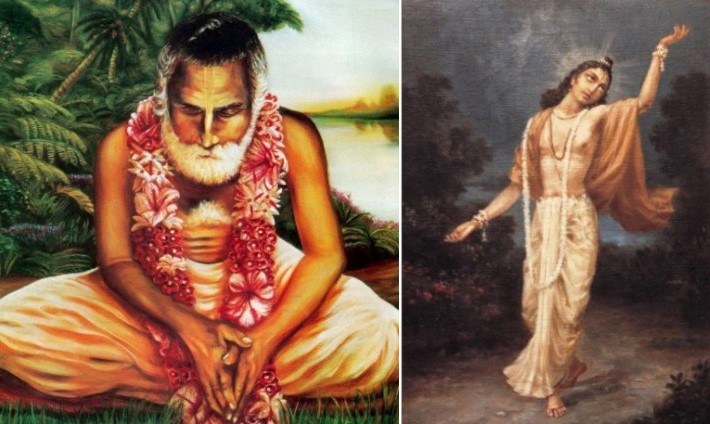
I have constantly drunk the most dangerous poison of sense gratification and so I could not merge myself into the sankirtan movement started by Lord Chaitanya.
Why am I living? What pleasure is life bringing me? Narottama asks, “Why did I not die long, long ago?”
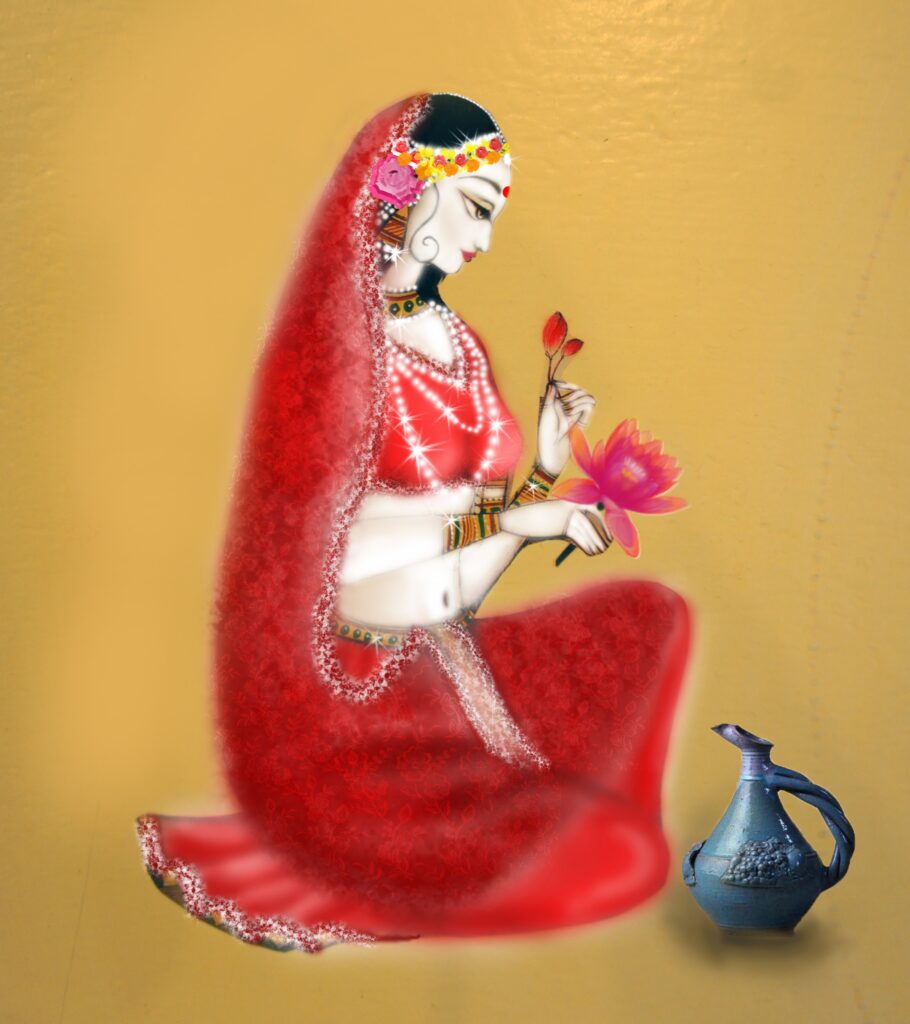
In Vraja lila Gaurakisora Das Babaji serves Srimati Radharani as the cowherd girl Guna-manjari.
I offer my respectful obeisances unto Gaurakisora Das Babaji Maharaja, who is renunciation personified. He is always merged in a feeling of separation from and intense love of Krishna.
[Excerpts from “Sri Chaitanya: His Life and Associates” by Srila Bhakti Ballabh Tirtha Maharaj and “Babaji Maharaja” by Karnamrita Das Adhikary]

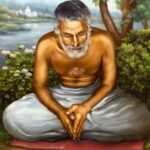
Comment
Truly wonderful reading about Srila Gaurakisora Das Babaji.Thankyou for taking the time to present this so nicely.